




The Chicago Transit Authority, Metra and Pace look for elusive dollars as lawmakers and others urge the three agencies to consolidate | PAGE 11

High-end new builds in Chicago are thriving as buyers seek custom homes and a booming luxury market |
When Eric Flanagan talks to potential buyers of a set of ve new multimillion-dollar homes he’s planning in Lincoln Park, the developer expects they’ll want to make changes from his standard seven-bedroom layout.
“ ey want two o ces,” says Flanagan, principal of Merrion Development Group, which has ve parcels on Grant Place, the last remnants of the old Lincoln Park Hospital site. “Or they want to combine three bedrooms to make a big second- oor family room.”
With the kind of money they’ll spend — his prices start at $4.1 million — “they want to make sure it ts their life, their family,” Flanagan says.

By Dennis Rodkin
The year is unlikely to close with more sales than 2022 and 2021, which both crossed the 100-sales mark.
The outrage over delivery fees has waned, but a lawsuit against Grubhub lives on.
Vacancies in behavioral health roles could threaten the CDPH’s plan to continue reopening mental health clinics across the metro area
By Katherine Davis
e Chicago Department of Public Health will enter 2025 with hundreds of vacancies as it struggles to recruit and retain workers across the agency — particularly for its behavioral health services.
Of the department’s 1,051 jobs budgeted for next year, about 280 are vacant, according to a CDPH spokesperson. And an ongoing citywide hiring freeze, rst announced in September, means those jobs will likely remain unlled for some time.
e number of vacancies would be even higher if the CDPH’s budgeted roles for next year had not shrunk by 124 positions, a move largely made to cut costs as Mayor Brandon Johnson works to close a projected $1 billion gap across the entire city budget.
Massive vacancies at the CDPH are not new. Year after year, the department, which is responsible for everything from restaurant inspections to delivering clinical care, has grappled with a high number of vacant roles.
CDPH Commissioner Dr. Olu-
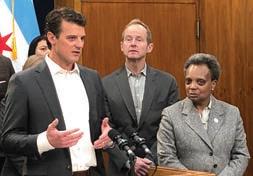
simbo "Simbo" Ige told the City Council in a budget hearing earlier this month that her department has struggled to hire workers, primarily because of an industrywide labor shortage of nurses, physician assistants and even doctors. But Ige emphasized the department also struggles to o er salaries that compete with the private sector, saying 100 job candidates rejected o ers from the CDPH this year.
“We are not very competitive in medical positions,” Ige told the council at the Nov. 7 hearing.
For example, the city is proposing o ering psychiatric nurse practitioners annual salaries between $127,000 and $131,800 next year, according to budget documents. Data from career site Indeed shows the average annual salary for that role in Chicago is about $130,000, but some psychiatric nurse practitioners are fetching as much as $179,000. And unlike the private sector, government salaries usually cannot be negotiated as much.
See HEALTH on Page 22
CRAIN’S LIST
See our annual ranking of the largest hospitals in the Chicago area. PAGE 8

The for-pro t education company focused on health care professionals is bucking the trend of downtown of ce tenants shrinking their footprints
By Danny Ecker
Adtalem Global Education is expanding its downtown headquarters and moving it to Willis Tower, a welcome piece of news for landlords as remote work keeps pushing the local o ce vacancy rate to new highs.
e for-pro t education company con rmed it will relocate its main o ce early next year to the city’s tallest skyscraper from 500 W. Monroe St. e new space will be split between two non-contiguous oors in the low-rise portion of the tower and total about 84,000 square feet, substantially more than the roughly 54,000 square feet Adtalem leases on Monroe Street today, according to sources familiar with the deal.
e larger footprint bucks the prevailing trend of space-shedding in the downtown o ce market, where the share of available space sits at a record high of nearly 26%. Companies have collectively unloaded almost 2 million square feet of workspace in the central business district since the middle of last year, many adapting to new COVID pandemic-changed work patterns.
A spokesman for Adtalem did not specify what prompted the need for more space, but said in a statement that the move “re ects our continued growth and will position us to better serve our key stakeholders.”
Sources familiar with the company’s plans said one of the new oors at Willis Tower will serve as
a corporate o ce, while the other will feature a training center. Adtalem has grown after narrowing its focus on education for health care professionals during the pandemic, churning out physicians, nurses and behavioral health professionals, among other aspiring workers in the industry.
Adtalem reported last month its enrollment at the end of the third quarter was up 11.2% year over year to 90,140 students, and its revenue was up by 13.2% over the same period to $417.4 million.
e company’s move is a victory for EQ O ce, the o ce division of New York-based private-equity giant Blackstone that owns Willis Tower and has poured hundreds of millions of dollars into renovating it over the past several years.
e 110-story building was nearly 86% leased without Adtalem, according to real estate information company CoStar Group, higher than the 74% average for downtown o ce buildings.
“We are excited to welcome Adtalem Global Education to Willis Tower and look forward to providing their team an elevated tenant experience with the best-in-class spaces and amenities that make Willis Tower a modern workplace destination,” a Willis Tower spokeswoman said in a statement.
On the losing end of the move is real estate rm Spear Street Capital, the San Francisco-based owner of the 46-story building at 500 W. Monroe. Adtalem is the
By Katherine Davis
Charles River Laboratories, a Wilmington, Mass., pharma services giant, is closing a Skokie o ce that will result in the elimination of nearly 100 jobs.
e company, which said it was cutting about 3% of its workforce in September, con rmed to Crain’s on Nov. 12 that its Skokie site will close by the end of the rst quarter in 2025. A notice led with the Illinois Department of Commerce & Economic Opportunity shows 94 positions will be cut from that site.
Sam Jorgensen, a Charles River spokesperson, said the company is working to place some laid-o employees at other Charles River facilities but could not say how many. Jorgensen also said the company is “working with impacted employees to provide the necessary resources” during the transition.
“As a global organization, Charles River is continuously eval-
uating our business operations,” he said. “A key part of that strategy is evaluating our global footprint to optimize, consolidate and simplify operations.
“These collective efforts are aimed at emerging as a leaner, more efficient organization when demand returns, a stronger partner to our clients and better positioned to capture new business opportunities as well as to protect and ultimately enhance shareholder value,” Jorgensen continued.
Layo s across the company's U.S. o ces came after it reported second-quarter revenue declines.
Charles River shares are down more than 7% since the beginning of the year, trading at about $216.
Aside from the Skokie o ce, Charles River has two sites in Chicago, including an o ce in Fulton Market and a research and development lab at the Illinois Institute of Technology.
third-largest tenant at the property, though its lease for the 12th and 13th oors still has another three years remaining, according to CoStar data. It’s unclear whether Adtalem will look to sublease its current o ce for the remainder of the lease term.
Spear Street has time to hunt for tenants to back ll the space, though it’s not the only vacancy the rm needs to address. Investment rm Antares Capital this year vacated nearly 70,000 square feet in the building and moved two blocks south to BMO Tower. Motorola Solutions is also looking to sublease more than 50,000 square feet in the tower, potentially competing for tenants with its own landlord.
Spear Street notched a key win earlier this year, however, when insurance broker Lockton added half a oor to its o ce in the building and extended its lease by a decade. e Kansas City, Mo.-based company now leases 66,725 square feet on a deal that runs until 2037. e 968,000-square-foot building is 82% leased today, according to CoStar, down from roughly 99% in 2019 when Spear Street bought the property for $412 million.
A Spear Street spokesman did not respond to a request for comment.
Adtalem was rebranded from DeVry Education Group in 2017 and subsequently moved its headquarters to 500 W. Monroe St. from west suburban Downers Grove.
e company also streamlined

its portfolio, selling o scandaltainted DeVry and other business lines and shifting its revenue model to reduce reliance on federal student loans and grants.
Adtalem has focused on health care education under Stephen Beard, who took over as chief executive of the publicly traded company in 2021 and bet heavily on a growing need for more professionals in the sector. Adtalem’s portfolio of schools today includes
online educator Walden University, nursing and health professional school Chamberlain University and three universities based in the Caribbean.
Shares of Adtalem opened trading today at just more than $90 apiece, up 54% year to date. Jones Lang LaSalle’s Meredith O’Connor and Jamie Wallenberg negotiated the new lease on behalf of Adtalem. Chicago leasing agency Telos Group represented EQ O ce.


“Wintrust, Chicago’s Bank®, and Eli’s, Chicago’s Cheesecake, is a match made in heaven!”
MARC SCHULMAN


The re nancing of 609 W. Randolph St. shows that some properties downtown look far better to lenders than others
By Danny Ecker
A New York developer just pulled o a feat that has eluded most of its peers over the past couple years: re nancing an o ce building in downtown Chicago.
Vista Property Group closed on a new $32 million mortgage backed by the 15-story o ce building at 609 W. Randolph St., the developer con rmed in a statement. e ve-year loan from JPMorgan Chase comes with a 7.23% xed interest rate and replaces a $30.7 million mortgage a Vista a liate borrowed in 2021 to nance construction of the 95,000-squarefoot building.
e re nancing stands out against an ugly backdrop in the vacancy-stricken downtown ofce market. Remote work’s assault on demand and elevated interest rates have hammered o ce property values below the balance of the debt tied to them in many cases, handcu ng landlords trying to pay o maturing debt and fueling a wave of foreclosures and other distress. Traditional lenders have also been wary of writing new loans for ofce properties while the prevailing trend of companies shrinking their footprints lingers.
But Vista’s new mortgage shows that some o ce properties look far better to lenders
than others. Brand-new buildings in easy-to-access locations with modern amenities are proving their appeal to companies hunting for workspace that will help encourage employees to show up more regularly. Vista’s building includes a penthouse lounge and conference room and o ces with private outdoor terraces, among other features.
The developer “was fortunate to have leased up 609 W. Randolph’s 15 oors of new construction to an impressive and diverse roster of high-quality full oor users.”
Hymie Mishan, Vista principal
Boutique properties like 609 W. Randolph are also far less risky than massive o ce towers with lengthy rosters of tenants that may be looking to change their workspace in the wake of the COVID pandemic. Vista’s building is close to 94% leased to

The move signals that the family owned and operated company, based in Woodridge and known for its tavern-style frozen pizza, is ready to expand and seek out new areas for growth |
Home Run Inn, the family owned and operated frozen pizza manufacturer and restaurant chain, will create an independent board as the company looks to continue the growth it saw during the pandemic.
e Woodridge-based company is seeking to create a ve- to seven-person independent board to help guide and support its next chapter. e board will include a couple of family members, according to CEO Dan Costello, and is anticipated to be in place by the end of the rst quarter of 2025.
Costello said the board will allow the family to learn from di erent perspectives and bring new expertise into the fold. It’ll also
By Brandon Dupré
“That willingness to look outside for assistance tends to preserve the family and the business and its af uence.”
Thomas Handler, an adviser of wealthy families and their businesses
Co-founder and former CEO Matt Maloney says problems that sparked the suit have gone away and so should the case

By John Pletz
Mayors and CEOs come and go, but litigation lives on long after they’re gone.
Grubhub co-founder Matt Maloney, who stepped down as CEO nearly three years ago, says he’s about to be deposed in a lawsuit led against food-delivery app companies by the city of Chicago when Lori Lightfoot was mayor.
e suit was led in late 2021, during the peak of both the COVID-19 pandemic and restaurants’ outrage over delivery fees and other charges that often totaled 30% or more of the retail price of the food. e case, and another one like
it against DoorDash, is moving through the evidence discovery phase. e city sued the companies for what it said were deceptive practices, such as listing restaurants on their platforms without permission and for hiding from customers the full amount of fees until the end of the transaction in what it contended was a bait-and-switch. e city also accused Grubhub of violating an ordinance designed to limit the commission it received from restaurants to 15% of the amount of the purchase. It further claimed the company created web pages (microsites) on behalf of restaurants that instead routed orders to Grubhub.
“I don’t think anyone is putting restaurants on (the platform) who don’t want to be on,” says Maloney, who moved to Michigan during the pandemic. “ at ended with COVID. e fee caps are gone. Microsites are gone."
“ e problem is the city is still pushing forward on litigation that, from a reasonable perspective, is already discredited," he said. " ey’re not recognizing the harm they are doing. . . .It doesn’t make sense.”
The city sued restaurant delivery platforms for violating consumer protection statutes. It also claimed Grubhub was
Under the $87 million deal, Surgery Partners, based in Brentwood, Tenn., will lead operations at the Lombard and Westmont locations
By Katherine Davis
Downers Grove-based physicians group Duly Health & Care has sold a portion of its ownership stake in two ambulatory surgery centers in the Chicago suburbs to publicly traded health care services company Surgery Partners.
e “long-term, strategic partnership" allows Brentwood, Tenn.based Surgery Partners to “lead operations” at Duly’s Lombard and Westmont surgery centers.
Duly sold 26% stakes in both the Lombard and Westmont facilities to Surgery Partners for $87 million, according to Duly spokeswoman Maria McGowan.
e Illinois Health Facilities & Services Review Board approved the transaction Oct. 31, according to state lings.
McGowan said Duly pursued this particular deal because it is expected to “elevate the performance” of its surgery centers while also supporting “expansion of Duly’s ambulatory surgery center footprint.”
It’s unclear exactly what might change for patients under the partnership, but Duly said in a press release today that Surgery Partners will “uphold the high quality of care standards that Duly is known for delivering to its patients.” e Lombard facility is one of the largest and busiest multispecialty ambulatory surgery centers in Illinois, serving more than 20,000 patients, according to Duly.
Duly CEO Dan Greenleaf declined an interview request on Nov. 13 but in a statement said:
“Our valued patients and the physicians and care teams that serve them are critical to our continued success as an organization. We made this decision following great discernment and are thrilled to work with Surgery Partners, the leading independent operator of surgical facilities. ey are an ideal partner for our independent, physician-led model.”
Ahead of the Surgery Partners deal, Duly proposed a similar deal with Deer eld-based Surgical Care A liates, state board documents show. Duly sought to sell a portion of its Lombard and Westmont centers to Surgical Care A liates, but it withdrew those applications in August and McGowan con rmed those deals were not completed.
Surgical Care A liates, however, still partners with Duly to operate its Naperville ambulatory surgery center.
Since its founding in 2004, Surgery Partners has grown to operate more than 200 facilities in 33 states, including ambulatory surgery centers, surgical hospitals, multispecialty physician practices and urgent care facilities. It merged with NovaMed in 2011, went public in 2015 and later merged with National Surgical Healthcare in 2017, according to its website.
As of December 2023, Surgery Partners owned or operated 162 surgical facilities, including 144 ambulatory surgery centers, a portion of the business that makes up about 98% of the company’s total

revenue, according to U.S. Securities & Exchange Commission lings. And more than half of its patient revenue comes from those with private insurance plans.
"We are thrilled to welcome two of Duly’s highly rated facilities to our national portfolio of leading surgery centers," Surgery Partners CEO Eric Evans said in a statement. "Duly exempli es the qualities we seek in a physician group partnership — in-depth market expertise and a superior patient experience. Together, we share a commitment to advancing patient care and quality, and we look forward to continued growth and success in our partnership."
In some cases, Surgery Partners will acquire surgical centers to expand. But in others, referred to as “strategic relationships,” the health care system or physician group maintains ownership of
the facility and Surgery Partners agrees to provide day-to-day management services for a fee equal to a percentage of the revenues of the facility.
“We believe that forming such strategic relationships can enhance our ability to attract physicians and access favorable private insurance contracts for our surgical facilities in that market,” Surgery Partners disclosed in its annual ling with the SEC.
e company, which saw revenue grow 8% to $2.7 billion last year, has taken investments from some of the country’s largest private-equity rms. Bain Capital Investors has a nearly 40% stake in Surgery Partners, according to Morningstar data. Meanwhile, BlackRock has a 6% stake.
e deal comes after a rocky period for Duly, the largest physicians group in the Chicago area,
according to Crain's research. While revenue grew 28% to $2.5 billion last year, according to data the company previously provided to Crain’s, signs of nancial distress became clear following two rounds of layo s last year and an April downgrade by a major bond credit ratings agency.
Moody’s Ratings said at the time Duly’s operating performance was deteriorating and that it carried a heavy debt load, partly stemming from a 2017 private-equity investment from Ares Management. Duly, which operates more than 150 locations in Illinois and Indiana, serves approximately 5.5 million patients annually and employs 6,000 people, about 1,000 of whom are medical doctors. Duly declined to divulge how many are employed at the Westmont and Lombard facilities.
By Dennis Rodkin
Fifteen months after a sexual harassment scandal rocked the National Association of Realtors and quickly took down both its president and CEO, the in uential Chicago-based trade association earlier this month unveiled a new set of standards aimed at ensuring better conduct and culture in the workplace.
e 11 policies include authoring a clear set of values that volunteers and employees should hew to, creating open pathways of accountability for any infractions and regular “anti-retaliation” training for top leadership.
Adopted by the NAR’s executive board on Nov. 10 and published yesterday, the standards “are a start to the change that is hard and necessary,” Christina Pappas, a chair of the NAR commission that made the recommendations, said in prepared comments.
President of Miami real estate brokerage e Keyes Co., Pappas
is the NAR member chair of the 75-member Culture Transformation Commission that the association set up in October 2023 amidst the controversy over its o ce culture.
“Culture is not built overnight and change takes time,” Pappas said in the statement. “We will need buy-in from all our stakeholders to ultimately achieve our goal.” e NAR has about 1.5 million members and about 350 employees, 200 of them in Chicago.
e new standards are “a rst step,” Nykia Wright, the NAR’s CEO, said in the published statement. “True culture transformation comes in our daily interactions.”
e recommendations come less than a week after the NAR announced another signi cant step in the rebuilding, the hiring of Sharon White as chief human resources o cer. In the press release announcing the move, Wright said White’s role “is pivotal to realizing NAR’s vision of be-

ing an inclusive, collaborative and high-performing workplace.”
Mantill Williams, the NAR’s vice president for public relations, said none of the group’s o cials would be made available for further comment to Crain’s. ese steps are intended to correct the image of sexually inappropriate and vengeful leadership that
the home-buying public may have gotten from an explosive New York Times investigation published in August 2023, as well as claims of bullying and retaliation that a former employee made in her federal lawsuit against the NAR.
One symptom of the tumult in the workplace was a September 2023 petition signed by sta ers
in the NAR’s Chicago and Washington o ces pleading to “be allowed to do our jobs in a respectful, healthy and productive environment.”
e New York Times described a permissive culture where the CEO, a sta er, essentially condoned sexual harassment perpetrated by the president, a volunteer. Both were out from their posts within months, followed swiftly by the president’s successor, who claimed to have been threatened with blackmail if she didn’t step down.
In the ensuing year, Wright and President Kevin Sears, a Springeld, Mass., real estate broker, have attempted to bolster the NAR’s reputation. At the same time, the association is navigating a tectonic change in the way homes are bought and sold, in the wake of a federal jury nding that the NAR and other players in the home-selling industry colluded for decades to keep real estate commissions high.
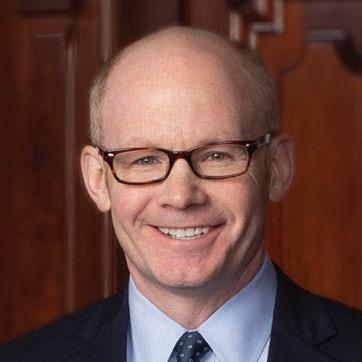








For what amounts to just over $10 million in potential revenue, Chicago Mayor Brandon Johnson is buying himself quite a headache.
at's the amount the mayor hopes to raise from a proposed 34% hike in the city's liquor tax — just one of several straws the Fifth Floor is grasping at in an attempt to plug a nearly $1 billion hole in his $17.3 billion 2025 budget plan.
e proposal would raise the tax on beer by 10 cents to 39 cents per gallon and the tax on spirits almost $1 to $3.62 per gallon. Other alcoholic beverages would also see taxes rise. At the liquor store, that would look like a 3-cent increase on a bottle of wine, a 6-cent increase on a six-pack of beer and a 19-cent increase on a bottle of liquor, according to the mayor’s o ce. e tax increase would result in an estimated $10.6 million in annual revenue.
In defending the liquor tax idea, Johnson's budget team tried to put the actual cost in perspective. " e liquor tax is pennies on a six-pack. Pennies," city CFO Jill Jaworski told Crain's in a budget brie ng earlier this month. And city Comptroller Chasse Rehwinkel emphasized that the administration looked to increase unitbased taxes — like the per-gallon tax on alcohol — because those have not risen along with in ation. e last time the alcohol tax went through a “major change” was in 2009, he said.
Duly noted. But to propose boosting the cost of alcohol now is to ignore the economic headwinds that have beset the city's hospitality industry since the pandemic — trends that threaten to stall the still-nascent restaurant recovery that's just starting to
take root in neighborhoods throughout the city, including the Loop.
As Crain's Justin Laurence and Ally Marotti report, in ation has driven the cost of eating out and groceries up about 30% and 26%, respectively, since 2019. As a result, consumers are ordering fewer drinks when they eat out, according to data from market research rm Technomic. A recent Technomic survey found that 59% of Midwestern restaurant or bar operators raised prices on alcohol in the past year, and 55% plan to do so again in the coming year. ose higher prices have caused 30% of Midwestern consumers age 21 and up to order fewer alcoholic drinks.
tion has focused on small restaurateurs, bar owners, liquor retailers and independent grocers who will inevitably feel the most immediate e ects if customers cut back on their purchases or head to the suburbs to stock up their wine cooler or enjoy an evening out. ese are businesses, it should be noted, that are still smarting from some of the Johnson administration's earlier measures: a mandatory wage hike for tipped workers and a new rule that requires 10 days of paid time o .
But it's also worth noting that Johnson's proposal sticks a thumb in the eye of much larger players in the city's business landscape. Chicago is home to major liquor
In exchange for a mere $10.6 million in new revenue, Johnson has sent a loud-and-clear message to one of the most important industries in the local economy:
I don’t care about you or your struggles.
In response, many Chicago restaurants are tailoring their wine lists in an e ort to keep prices down for their customers, as Marotti has reported. Red wine menu prices are up 19.4% year over year, putting it at the top of Technomic’s list of alcoholic beverage price hikes. Champagne and sparkling wine are close behind with an 11.1% increase. Spirits and beer, in comparison, are respectively up 5.8% and 4%.
Johnson's proposed booze tax hike has received colossal blowback from the hospitality industry. Much of that conversa-

industry employers — Wirtz Corp. dominates the distribution game, for instance; beer giant Molson Coors is headquartered here; Beam Suntory and Constellation Brands have a major presence in town; and midsize distillers and brewers also make up a growing portion of the city's consumer products industry. And don't forget hotels, which also derive revenue from their bars and restaurants — some of them among the city's nest.
In Team Johnson's brie ng with Crain's, Jaworski downplayed the e ects. "It’s easy
to jump to these conclusions that it’s going to have a very negative impact on a group of people, when in fact the impact is quite small. If we choose every time there’s some impact to say, ‘We’re not going to do it,’ we’re never going to be able to close our budget gap. e government has to function, and we have to nd revenues.”
Of course, there is an alternative to nding revenue, and that's cutting. But the Johnson administration isn't up for that. In fact, the 2025 budget is 3% bigger than the 2024 budget.
On the heels of a punishing pandemic that drove many restaurants out of business, the in ation that followed and the labor-friendly measures pushed through by City Hall, it should hardly have been surprising that the hospitality industry reacted to the liquor tax hike with maximum force. And given the intensity of that response, it's possible Johnson's booze tax idea is already dead on arrival, judging by Crain's conversations with City Council members.
But even if Johnson endures the fallout and somehow wins the votes he needs to support the liquor tax plan, one has to wonder if the juice is worth the squeeze, to put it in a bartender's terms. In exchange for a mere $10.6 million in new revenue, Johnson has sent a loud-and-clear message to one of the most important industries in the local economy: I don't care about you or your struggles. And for an administration that needs all the help it can get to revitalize neighborhoods — the kind of e ort where restaurants, bars and retailers play a vital role — that's a lousy message to send.
Irecently took the train to a Chicago Bears game. It was cheap, fast, safe and a genuinely good experience.
e only issue? I was in London, where reliable public transportation makes it easy to get to your local sporting event. Here in Chicago, that option doesn't exist for the Bears. Especially since the pandemic, our transit systems have been riddled with crime, delays and chaos.
A world-class city such as Chicago deserves a world-class public transportation system. Chicagoans want better transit opportunities. To bring about reform and get the city to a thriving system, Chicago needs to overcome a growing sense of disarray and several obstacles.
e most pressing problem for the city is budget mismanagement.

els of crime and delays. A trip downtown on the Brown Line could mean a 20-minute wait for a train. It's no surprise ridership is down 40% since the pandemic.
e CTA must rst cut frivolous spending, such as $40,000 in taxpayer funds on a station DJ; start focusing on resta ng more than 300 vacant operator positions; and re-evaluate costly, ine ective security contracts that haven't deterred crime. Additionally, the agencies can expand discount options to encourage Chicago ridership, which under the leadership of President Dorval Carter has lagged nearly every other major transit city since 2021.
cause the city must pay investors for parking spaces lost to transit infrastructure.
While the investors have pro ted, the city is on the hook for revenue from 30,000 meters at all times. Investors must be reimbursed for any "lost" revenue from events, street closures or parades. If Chicago creates a new bike or bus lane, every spot removed from use needs to be installed in a di erent location of equal value. Otherwise, the city must pay the di erence.
To overcome this, citizens could consider legal challenges to void the contract as being "manifestly contrary to public policy." Early versions of this argument lacked substance, but every year the impact to the city's nances and transportation policies is increasingly evident. e once-speculative public harm is now proven by millions of wasted tax dollars.
it has Mayor Brandon Johnson's support. While leaders sell this as a public-safety initiative, it's just a cash grab. Lowering the speed limit will drastically increase the number of speed camera tickets issued as they hit any driver going 31 mph.
Research has shown speed cameras have limited to no e ect on public safety. ey do make money. After former Mayor Lori Lightfoot in 2021 started ticketing drivers going between 6 to 10 miles over the speed limit, the city doubled its revenue, collecting over $100 million per year. ese types of regressive nes disproportionately harm members of Black and low-income communities. ose Chicagoans also have the largest gaps in public transportation options.
Illinois' transit leaders are currently on a press tour demanding a $1.5 billion bailout from Spring eld to avoid a combined $730 million shortfall for the Chicago Transit Authority, Pace and Metra in 2026. After years of scal mismanagement, these calls feel tone-deaf.
e CTA's budget has grown 30% since 2019. Yet it's still plagued by elevated lev-
Rather than dish out tax dollars to subsidize a new stadium, why not invest in connecting Soldier Field and the Museum Campus to the rest of the city?
e other obstacle the city faces is a 75year lease of the city's parking meters to private investors. at deal has dug the city into a scal hole and considerably limited its options for transit reform, be-
Most important, the city seems to lack willing leaders who truly want to bring a vision of a strong public transportation system to life. Instead of debating new possibilities, many city leaders are instead focused on sneaking in fee hikes disguised as pro-transit initiatives.
Just weeks ago, a City Council committee advanced a resolution to lower the citywide speed limit to 25 mph from 30 mph, and
And it's not the only way we harm those with fewer means. e City Council O ce of Financial Analysis has outlined plans for a "congestion tax," which would punish everyday commuters during busy periods. e city of Chicago needs a new vision for the CTA and public transportation, not more taxes and fees. It starts with new leadership and the removal of Carter, who rarely uses the CTA and has been criti-
See TRANSIT on Page 7
At the Democratic National Convention, Mayor Brandon Johnson and Gov. JB Pritzker painted a rosy picture of Chicago and the state of Illinois. Unfortunately, data on Chicago’s population decline tell another story.
e Census Bureau’s estimate of Chicago’s population as of July 2023 (numbers are typically reported on a delay of nearly a year) counts 2.66 million residents in the city. After nine straight years of population loss, the city is at its lowest population in over 100 years, having had a population of 2.7 million in 1920. A study by the Federal Reserve further notes that both high-income and low-income parts of the city have faced population loss, with low-income areas losing the most residents.
Leadership remains unwilling to address the crime rates and costof-living increases driving these losses. Until they enact meaningful policy reform to mitigate the problems, residents from every tax bracket — but particularly those in low-earning households — will continue to seek opportunities for better quality of life elsewhere.
In many cities, out-migration has been a motivator for political leadership to get serious about the causes of population decline. Yet Johnson claimed the issues behind the population loss “remain deeply rooted in historic disinvestment,” and cited “lack of a ordable housing, loss of jobs, and closed schools and mental health clinics” as primary factors. But anybody who believes Chicago has been disinvesting in those areas should look at the city’s budget, which has grown at an average rate of 8.2% per year since 2011.
Johnson even de ected by claiming that, if asylum-seekers are counted, the decline wouldn’t be nearly as bad. is should be insulting to any longtime Chicagoan who has witnessed the city’s decline as well as the unprecedented special treatment received by migrants at the expense of Chicago taxpayers —
to the tune of $460.3 million since August 2022. Mayor Johnson’s focus on migrant numbers evades the real problem: Chicagoans are leaving because the city doesn’t provide the quality of life that other places do, and that’s in large part due to state and local policy.
ere is one area where Chicago leadership truly has disinvested from in recent years: ghting crime. Of the 10 most dangerous neighborhoods in Chicago, nine lost population on net between 2010 and 2020. Meanwhile, Chicago’s murder rate last year far
surpassed those of peer cities by a wide margin — nearly triple that of Los Angeles and a whopping ve times greater than New York’s. Other major cities are far safer for those who prefer dense urban life, while those open to living in suburbs have safe options both near Chicago and all over the country. Until Chicago prioritizes ghting crime over disputing population counts, we can expect more people to leave the city’s struggling neighborhoods.
In the COVID era, relocation became much more common, with a clear nationwide preference for
freer states with lower taxes (Illinois has the worst taxes in the nation), which contribute to an overall lower cost of living. Meanwhile, Chicago rents rose 21% in 2024, just as Illinois has become the hardest state in the nation to build new housing. All of these contribute to a higher cost of living than longtime residents are used to and, until the city and state change course, will lead more Chicagoans to search for opportunities elsewhere.
ese issues have a ected people across the income spectrum. However, as the Federal Reserve’s study
showed, lower-income neighborhoods have lost residents faster than wealthier areas. Even as Johnson and Pritzker pretend to stand up for those communities, the burdens of the decline of quality of life in Chicago are hardest on those with fewer resources. e city needs leadership that will address crime and the cost of living honestly and without irrelevant excuses.
Mike Viola is a state beat fellow at Young Voices, a nonpro t public policy forum headquartered in Washington, D.C.

cized for his failure to manage its day-to-day operations, as well as Johnson appointing inexperienced board members to the RTA. New leaders must think creatively about Chicago's transit. Whether that's merging the area's four transit agencies to save money, an initiative polling shows is supported by Illinoisans by a 2-1 ratio, or implementing e ective speed reduction strategies such as speed bumps or "your speed is" signs rather than relying on speed cameras. It should mean prioritizing bus and bike lanes instead of car lanes when reconstructing DuSable Lake Shore Drive. Most important, new leaders can consider how to work with the Chicago Police Department to guarantee safe passage on the train.
Other cities have gured out how to run a transit agency postpandemic. Chicago can, too.

Options for vibrant culture, delectable cuisine and unforgettable entertainment.
Visit our website for our locations across Chicagoland morettisrestaurants.com
Moretti’s was founded in Chicago and is 100% family-owned and exclusive to the Chicago area. The original Moretti’s is on the northwest side of Chicago. Ten other locations serve the north and west metro area. Moretti’s original family recipes range from traditional to the latest delicious trends. All ingredients are fresh, and everything is handcrafted to order.



101 E Erie St, Chicago, IL 60611
312-667-6800 • 101club.com/101-room
Experience the newly opened 101 Club American Grill on the 20th oor, featuring stunning views and a sophisticated mid-century design. Savor impeccably prepared American favorites like steaks, chops, fresh seafood and upscale comfort food. Elevate your next gathering with 101 Club’s private and semi-private event spaces — perfect for beautiful weddings, corporate meetings and holiday parties up to 300 guests.






The focus will be on the snacking segment, which includes candy brands such as M&M’s, Snickers and Wrigley’s, and a pet care division
By Ewan Larkin, Ad
Mars Inc., the consumer packaged goods conglomerate, is set to launch a sprawling global agency review, Ad Age has learned.
e review is focused on Mars Snacking, which includes Mars candy brands such as M&Ms, Snickers and Wrigley’s, as well as Mars Petcare, which encompasses brands such as Pedigree, Cesar and Royal Canin. Mars Food & Nutrition, which includes brands including Ben’s Original, Seeds of Change and Masterfoods, is not part of the review.
e goal is to narrow down the number of agency partners those units work with, according to a person familiar with the matter. e review will include media, commerce, social media, brand PR and in uencer marketing. Creative will not be a ected.
“As part of our planned review of our agency partners, we are taking this opportunity to ensure we are set up to continue delivering best-in-class brand building. As a result, we are initiating RFP processes across several capability ar-
eas within our consumer brands and expect the process to conclude in 2025,” a Mars spokesperson said in a statement.
GroupM’s EssenceMediacom currently handles the global media account, which it retained in 2022 following an internal review. Mars consolidated its global media buying and planning with what was then Mediacom in 2018, taking business away from Publicis Groupe’s Starcom and Omnicom’s OMD. GroupM declined to comment on the upcoming review. (Mediacom has since merged with Essence to form EssenceMediacom.)
Several other holding company agencies work with Mars. Omnicom, which handles creative through agencies including BBDO and DDB, could not immediately be reached for comment. Mars United Commerce, which was recently acquired by Publicis Groupe, works with Mars Snacking. Publicis Groupe declined to comment. Interpublic Group of Cos.’ Weber Shandwick manages the bulk of brand PR for the company. IPG referred calls to

comment to the client.
“We are committed to conducting a fair and transparent RFP that respects the contributions of all our partners and we are grateful to our incumbent holding companies—each of whom has been invited to participate in the RFP—for their partnership,” the Mars spokesperson said.
Ad Age Datacenter estimates Mars Inc.’s worldwide ad spending at $2.4 billion in 2023. e
company had U.S. measuredmedia spending of $305 million in the rst two quarters of 2024, up from $289 million during the same period of 2023, according to data from Vivvix, including paid social data from Pathmatics. Mars spent $626 million in U.S. measured media during all of 2023. Mars in August agreed to buy snack marketer Kellanova, which spent $633 million on advertising in 2023 and recently wrapped a re-
view in which it expanded its relationship with IPG. e Kellanova deal is expected to close within the rst half of 2025. e Mars review isn’t anticipated to have an impact on Kellanova’s agency relationships, according to the person familiar with the matter. Mars declined to comment on how the review would impact Kellanova agency relationships. Ewan Larkin writes for Crain's sister brand Ad Age.



The Chicago Transit Authority, Metra and Pace look for elusive dollars as lawmakers and others urge the three agencies to consolidate | By Cassandra West
Public transit is a convenience and a frustration for Joey Stern. e 23-year-old Lincoln Park resident relies on the el and occasionally a bus to get to his job as a program manager for a tech startup near the Merchandise Mart. e Brown Line, he says, has been fairly reliable, but he's had “much more not-so-great experiences riding the bus.” Inconsistent service has at times forced him to walk farther or to be late for work.
Since Chicago Transit Authority riders started returning to their o ces and commuting picked up — though
not to pre-pandemic levels — complaints and frustrations over unreliable service have given rise to venting online via the @CTAFails tag on social media and its companion blog, subtitled "Documenting the disaster that is the Chicago Transit Authority."
Still the daily transport mode of choice for hundreds of thousands, the CTA earlier this month returned rail service to pre-COVID levels, adjusting service to match increased weekend and reduced weekday rush hour
See TRANSIT on Page 12

billion


demand. For those who depend on the CTA to get them where they need to go, that may be better late than never. But the CTA, along with Metra and Pace Suburban Bus, which all are under the oversight of the Regional Transportation Authority, are in for a rocky road ahead. at means the region's transit riders are, too.
Federal funding to the tune of $3.5 billion has helped the transit agencies through the big drop-o in ridership and revenues since 2020. ose dollars will be exhausted by 2026, and together, the transit agencies face a looming scal cli — a $730 million budget de cit that's expected to balloon to $1.2 billion in 2031, the Chicago Metropolitan Agency for Planning projects. "While the region’s transit system has faced funding crises before, the scale and scope of this crisis is unprecedented and unique," CMAP says.
A scramble for solutions is on. One put forth is the Metropolitan Mobility Authority Act, introduced earlier this year in the Illinois General Assembly. It aims to establish a framework for operating transit throughout the state. e MMAA would combine the CTA, Metra and Pace into a single transit agency and allow riders to use one pass for any operator, which legislators estimate will save $250 million a year.
“We have a unique opportunity to reimagine transit in a way that genuinely transforms the experience for everyone in our region,” said state Rep. Eva-Dina Delgado, D-Chicago, the bill’s co-sponsor. “ e current structure, divided among 47 board members across four separate boards, creates competition instead of collaboration, often putting the city and suburbs at odds and spreading resources thin.”
A festering problem
e federal aid put a bandage on a problem that was festering years before the pandemic began, says Ian Savage, associate department chair of the transportation and logistics program at Northwestern University. “Around 2014, transit ridership started declining across the nation" as more people and businesses migrated to coastal states.
Transit experts noticed something else happening during that decade: a direct correlation between increased usage of ridehailing services and decreased CTA ridership. As companies like Uber and Lyft became an alternative to public transportation, falling ridership meant less fare revenue.
e nancial structures for the CTA, Metra and Pace began to get shaky, Savage says.
One reason is that Illinois requires the CTA, Metra and Pace to recover 50% of their operating expenses through fares and other charges. In light of the pandemic's impact on ridership, critics blast-

similar timeline, according to the agencies.
Without new funds, the three agencies' options would be limited. e scale of the budget gap — roughly 20% of annual operating costs — cannot be sustainably solved with cuts and increases alone. Addressing this gap could require cutting service by 30% to 40%, CMAP estimates. Service cuts to that extent would lead to a vicious circle: Cuts would lower ridership, which would mean less fare revenue, which would require further cuts to address the growing budget gap.
e consequences would be felt throughout the region by residents, employers, local governments, schools and visitors, among others.
in commute patterns,” says Tom McKone, the CTA’s chief nancial o cer. “A lot of this is about having that exibility to evolve, to meet those ridership demands and those changing patterns, while acknowledging that the veday-a-week, 9-to-5 commuter just is not going to look the same as it did. But that doesn't mean there's no opportunities.”
CMAP has laid out what it calls the "Plan of Action for Regional Transit." In one of the more ambitious proposals, CMAP recommends the transit agencies plan for fare increases that keep up with in ation. e plan estimates $100 million in additional revenue if fares are increased in 2026. It doesn’t state how much fares would have to increase to reach that estimate, but it does say, “If the bus is not running when a traveler needs it, it does not matter whether the fare is $2 or $10.”
All the transit operators are facing the prospect of cuts and fare increases if funding solutions aren’t found, despite the CTA and Pace already increasing fares in 2018. e most impacted will likely be lower-income residents in the least accessible parts of the city, says Micheál Podgers, policy director at Better Streets Chicago, a transit advocacy organization. “ e Belmont bus (on the North Side) is not getting cut anytime soon, but the cuts would hit riders who need transit the hardest,” he says. “ e 85A out in the Northwest Side, where I used to live, operated seven days a week in 2008. By the time I was in high school, it operated ve days a week, which impacted people’s lives in a real way.”
Any additional service cuts will likely impact buses the most due to their service already experiencing regular delays compared to trains, according to transit riders who spoke with Crain's. “Anytime I used the bus, it's been a little spottier,” said Lydia Walters, who lives in Ravenswood. “Weekends would be the biggest thing. I would save a lot of money on Lyfts if (public transit) was more consistent over the weekends.”
ed this system-generated revenue recovery ratio requirement as unrealistic and overly burdensome.
e General Assembly last year reduced the ratio to 42% until 2026 to help compensate for reduced ridership.
Before the pandemic, the federal government didn’t give subsidies to local transit agencies, Savage says. Yet federal relief funds were critical in maintaining transit service in the Chicago region, government watchdog the Civic Federation has noted.
e CTA balanced its scal year 2024 operating budget with $472.5 million in federal COVID relief funds, approximately 24% of the entire operating budget.
e CTA board on Nov. 1 approved its $2.16 billion operating
budget for 2025, lling the gap with nearly $500 million in federal relief funds. ose funds will be exhausted by the next year, forcing the CTA to balance its projected 2026 budget de cit of $577 million by either nding additional revenue sources or making severe service cuts — or a combination of both.
RTA system ridership has made a slow but steady recovery from the pandemic. Ridership for 2024 is budgeted to continue recovering to an annual total of 349 million rides, an increase of 7.4% from 2023 but only 62% of the preCOVID 2019 level of 562 million rides.
e CTA expects to run out of its federal relief funds by early 2026, while Metra and Pace anticipate a
Transit advocates, lawmakers and CMAP have been working on a plan that, if adopted, would infuse up to $1.5 billion in new funding for the CTA, Metra and Pace.
e funding could come from a variety of new taxes and fees outlined in the CMAP report. Dorval Carter, the embattled CTA president, said earlier this year the agency hadn’t identi ed which of those it would advocate for with lawmakers, WTTW reported.
In the meantime, the CTA says it is looking at how to increase funding through increasing ridership. Fares account for 81% of the agency's revenue. e CTA says service expansion beyond business hours could boost gains. at's based on weekend ridership reaching 90% of pre-pandemic levels. All ridership is up 14% year over year, giving the agency con dence that ridership will keep rising.
“We’ve de nitely seen a change
Low-income residents have another dynamic working against them, Savage says. Unlike in some other cities, Chicago-area residents of all income levels use transit on a regular basis, with Metra’s primary clientele commuting on the rails to corporate jobs in the Loop and CTA and Pace buses transporting essential workers.
“It’s an interesting power play going on, with who would have to see the cuts if you have to make them,” Savage says. “Will wealthier people have enough clout to preserve services in their markets?”
Public safety quandary
Delays and other disruptions in service aren't riders' only woes. Violent crime has increased and incidents per CTA passenger trip have more than tripled since 2015, according to a WBEZ analysis. Violent crimes on buses, trains and other CTA properties during the rst eight months of
this year totaled 656.
e violent crime rate has reached 3.4 per million CTA passenger trips compared to 1.1 per million in 2015. In September, a man was charged with four counts of rst-degree murder after he was arrested for allegedly shooting multiple victims on a train at the Forest Park Blue Line station.
“I don’t use the CTA often, mostly because of safety,” says Mitchell Fabian, a River North resident. “It is oftentimes more inconvenient than driving, but sometimes faster than tra c. It is usually pretty dirty as well. I prefer to walk instead if it’s a shorter distance.”
With the stakes this high, the agencies are looking to the state to ll the funding gap. But they might not be as enthusiastic about the proposal making its way through the Legislature.
ose supporting the MMAA are championing consolidation as a way to help reduce disruptions in the transit systems. Riders regularly experience delays and poor communication from sta . e hope is that a more interconnected transit system would address disruptions in an e cient manner.
A poll conducted in September found Chicagoans support merging the area’s four transit agencies by a 2-1 ratio. e survey found 54% of Chicago residents support the merger versus 27% opposing it. In suburban Cook County, 53% of those surveyed support a merger versus 19% against it.
e di erent transit agencies have come out against consolidation e orts, saying each operator serves a di erent community. e CTA says it receives the largest amount of state funding, 46% of the allocated funds, because it has 84% of the region’s riders.
Delgado, the state representative, says having separate agencies contributes to delays, creates gaps in service and fosters ine ciencies in infrastructure development. Consolidation would connect residents “across city and county borders without unnecessary hurdles.”
While the MMAA would provide adequate funding, it might not go far enough in making transit more equitable. To address that would require a progressive income tax, meaning high-income households pay a higher percentage than lower-income families, says Kate Lowe, associate professor of urban planning and policy at the University of Illinois Chicago.
“A progressive income tax in Illinois will produce better public goods like transit, and that’s a winner for everyone,” Lowe says. “ e other heavy political lift would be using federal funds for operating. Federal dollars have to go toward tracks . . . and not operating.”
A at tax is currently required by the state constitution, but there might be an appetite for change. Earlier this month, Illinois voters overwhelmingly backed an advisory question calling for a 3% tax on millionaires to address property tax relief. e referendum is

“We have a unique opportunity to reimagine transit in a way that genuinely transforms the experience for everyone in our region,” says Illinois Rep. Eva-Dina Delgado, D-Chicago, a co-sponsor of the Metropolitan Mobility Authority Act, introduced earlier this year in the General Assembly. | MICHELLE KAFFKO/ORGANIC HEADSHOTS
CTA bus CTA rail Metra
nonbinding, but it could give lawmakers a case to call for reform.
Under the proposed MMAA, the board for the merged transit agency would consist of 19 members, with three appointed by the governor, ve by Chicago's mayor, ve by the Cook County board president and one each by the chief executives of DuPage, Kane, Lake, McHenry and Will counties. is would essentially give equal representation to the city of Chicago, Cook County and the surrounding collar counties.
ose skeptical of the MMAA worry it doesn’t properly address transit’s funding shortcomings and takes too much power away from Chicago. e city is the most diverse area in the state, and having a consolidated agency’s board consisting of members who live outside Chicago could raise con-
cerns regarding representation, Lowe says.
“ e city is not the only place that Black and Brown residents live, but it's the highest concentration, so I think there's signi cant risk in consolidation,” she says.
Transit may be facing a direnancial shortfall, but that hasn’t stopped expansion projects from moving forward. e CTA has the green light for a South Side expansion of the Red Line and expects to break ground next summer. e project’s budget increased to $5.3 billion to cover ballooning costs for construction materials, labor and nancing.
e agency is receiving about $2 billion of federal funds for the project and $950 million from Chicago’s tax-increment nancing program. e rest of the funding will be secured through additional
federal and state dollars, as well as CTA-issued bonds. e project is scheduled to be completed by the end of the decade.
ese plans came together under the Biden administration, but funding could be more challenging to secure under another Trump administration. e president-elect has suggested rolling back federal programs, such as the In ation Reduction Act, and infrastructure bills. During the Biden administration, Illinois bene ted from these signature federal relief measures.
A week after the election, Bloomberg reported, "Project 2025, the far-right handbook widely seen as the Trump 2.0 bible, describes eliminating funding for biking and walking paths, ending support for transit expansions and replacing many federal programs with block
grants to the states."
Even if Trump were to attempt to reel in these programs, it would likely be a long and tenuous battle navigating the bureaucratic process they fall under. ese federal funding dollars are likely safe, but it is apparent Illinois will be working with a less compliant White House.
“ ere’s been a long history behind what has been promised in terms of (the Red Line) extension . . . a promise that one day this line would be extended to the limits of the city,” McKone, the CTA's CFO, says. “ e stars aligned by having support at the federal level for transit projects focused on equity. e extension is going to be a driver of a rebirth and a rejuvenation for a part of the city that has long been neglected.”
— Pawan Naidu
contributed

The country’s second-largest public transportation system, the Chicago Transit Authority, has struggled to recover after the pandemic. Four years after COVID’s onset, the number of commuters using the CTA is well below 2019 levels, largely due to sustained workfrom-home policies reducing daily demand.
CTA ridership in 2023 was roughly 60% of 2019’s numbers.
e Windy City lags behind other major U.S. cities in this regard: Washington, D.C. (75%), Los Angeles (74%) and Boston (63%) have all recovered greater percentages of their passengers. Chicago is underperformed only by New York City (58%) in this area. And according to a Harris Poll survey, less than half (43%) of Cook County residents regularly use public transportation (i.e., ride once a month or more).
Up to this point, $2.2 billion in federal COVID relief has kept the struggling CTA a oat, serving as an expensive patch on a larger crisis. When the relief dollars run out, likely in early 2026, the CTA will be staring down a $730 million budget gap. Without a
funding solution, the Regional Transportation Authority warns, the CTA may have to reduce service by 30% to 40%. e CTA has already cut rail service by 22% and bus service by 7%.
Is there a solution to the system’s looming scal cli ? A third (29%) of regular public transit riders are concerned about public transportation where they live. e often-criticized CTA
President Dorval Carter along with some lawmakers want increased state funding paired with ambitious infrastructure improvements.
Illinois has chronically underfunded its public transit: e state funds 17% of Chicago’s public transportation system, signi cantly less than what most states contribute to their major cities’ public transit. Philadelphia (50%), Boston (44%) and New York City (28%) all receive signi cantly larger portions. Arguing that Chicago cannot sustain a world-class transportation system without su cient resources, some lawmakers want Illinois to provide an additional $1.5 billion in state funding for mass transit annually.
Historically, federal and state dollars have disproportionately funded highways rather than public transit (80% vs. 20%, respectively). at said, only a fth (20%) of Cook County residents and 31% of regular riders want local leaders to prioritize investments in alternative transportation systems (e.g., public transportation, nonvehicle transportation) over investments in traditional transportation systems (e.g., roads, highways). is hardly represents a groundswell of support.
In September, Carter proposed an improvement plan to attract riders by increasing the system’s usability and reliability. But he has not o ered a price tag for these proposals. With the CTA's already unbalanced budget, can Chicago a ord to undertake ambitious infrastructure updates? Advocates portray these costs as investments, asserting that Chicago transit helps generate $35 billion in economic activity each year. Expanding the CTA could also spark growth in new areas of the city. A third (31%) of Chicago and Cook County residents agree that investments in public transporta-
tion can help attract new residents and businesses.
Carter’s plan would likely resonate with the 40% of regular riders, and 25% of infrequent riders, who say that public transportation in their area should be expanded. Among infrequent riders, 18% do not use public transit regularly because it is too limited.
Would expanding routes entice these residents to swipe their Ventra cards more often? It is hard to know. ese are minorities of riders to begin with, and people’s prospective behaviors often don’t bear out when hypotheticals become reality. Investing in infrastructure may not be the cure to what ails the CTA if o ce workers still have little reason to travel to the Loop, and — perhaps most importantly — residents’ underlying concerns of safety remain unresolved.
e easiest lever to pull in increasing ridership seems clear: Cook County residents want better safety on the CTA. Nearly half (42%) would use mass transit more if it felt safer to do so. Only a quarter (27%) cite improved reliability as something that would spur usage.
concerned about safety


Do you agree with the following statement? “I would use public transportation more if it was safer.”
Land use advocates don’t want to see the city abandon its commitment to putting housing near buses, trains
By Pawan Naidu and Jocelyn Allison
Five and a half years ago, Lydia Walters sold her car as she prepared to move to Chicago, banking on finding an apartment close to public transit.
She now lives a two-minute walk from the CTA Brown Line in Ravenswood, taking a 45minute train ride to her job in the Loop.
“It’s important for me, every time I look for a new apartment, that it's accessible to me for whatever line I use for work,” the 29-year-old says.
Living within walking distance to public transit is a priority for many Chicagoans, whether it’s to make commuting easier or because they can’t afford to get around the city any other way. City officials have made residential development near Chicago Transit Authority and Metra a priority in recent years, amending zoning laws and providing grant funding to entice developers to build more units within walking distance of trains and buses.
But massive budget shortfalls at the Chicago area’s public transit agencies threaten to derail future projects, advocates say. While funding for transit-oriented development doesn’t rely on transit agencies’ budgets, a healthy network of trains and buses is necessary to draw both developers and potential tenants.
“If we don’t invest in transit, I think it could be a turning point next spring for (equitable transit-oriented development),” says Audrey Wennink, senior director at the Metropolitan Planning Council, a policy organization focused on the Chicago region.
“People understand the consequences if we don’t invest in transit,” she says. “The implications are very great, in terms of current developments that are near transit and future transit developments as well.”
The CTA, Metra and Pace are facing a combined $730 million budget shortfall in 2026 as pandemic-era relief funds are set to expire. With rising operational costs, a slow recovery in ridership following the COVID19 public health crisis and ongoing challenges in securing funding, the agencies could be forced to cut service or pull back on capital improvement plans.
In its 2023 report on the future of transit in northeastern Illinois, the Chicago Metropolitan Agency for Planning noted the

critical role development plays in a healthy transit system, saying the region cannot meet its ridership goals without development near buses and trains.
“One of the most important factors contributing to the success (or failure) of a transit network is the land use and development in which the system operates,”
The
CTA,
sit stations. Since that time, the city has reworked the zoning code to make the projects, known as ETODs or TODs, easier to plan and invested $10 million in grants toward these developments.
Several projects have started to take shape, including the 43 Green development in Bronzeville,
Metra and Pace are facing a combined $730 million budget shortfall in 2026 as pandemic-era relief funds are set to expire.
CMAP says in the report.
But most development has been happening in areas with limited or no access to public transit. From 2000 to 2015, about three-quarters of all residential and non-residential development in northeastern Illinois took place in areas with limited transit availability, the report found. Across the region, 47% of residences and 45% of jobs have limited or no access to bus or rail lines, the agency says.
But the tide has been turning.
In 2020, Chicago adopted the Equitable Transit-Oriented Development Policy Plan to encourage development near tran -
which sits across the street from the Green Line station at 43rd Street. Another is a ve-story development with 54 apartments slated for the northeast corner of Addison Street and Ravenswood Avenue in Lakeview.
When units became available at 43 Green last spring, the 49 market-rate apartments leased up in a few weeks. e second phase is yet to start construction, but the other 50 units, reserved for people who meet the city’s income guidelines for a ordable housing, are about one-third leased.
Advocates say the availability of affordable housing near pub -
lic transit is especially critical for lower-income residents, many of whom can’t afford a car.
“ETOD lowers the cost of living by making it easier to get around on public transit, reducing the need to drive and the costs associated with cars,” says Juan Arias, executive director of nonpro t organization Elevated Chicago, which is focused on equitable development of public spaces.
“ETOD also increases access to jobs by increasing the number of businesses accessible via public transit,” Arias says. “The focus on equity in ETOD also means that we prevent displacement of low-income residents by building affordable housing, investing in community ownership, and protecting the existing stock of naturally occurring affordable housing.”
Along with sufficient funding for the city’s transit systems, several policy changes could encourage transit-oriented development, advocates say, such as eliminating requirements that developers create a minimum number of parking spots in their projects.
“It could be a very helpful tool to allow developers to build only the amount of parking they believe the market needs,” the MPC’s
Wennink says. “(Minimum parking) is a barrier, because when you’re trying to build in dense areas, parking adds costs . . . and makes it less safe.”
e city could also get rid of a ban on two- and three- ats in TODs, which “limits housing options for families and makes housing more expensive,” Arias says.
In its regional transit report, CMAP recommends making better use of parking lots at transit stations that have seen fewer cars as ridership has dropped. Incentives such as grants, loans and tax credits could help local communities redevelop publicly owned lots, the agency says.
The agency also calls for streamlining the approval process for TODs and for transit agencies to consider taking a more active role in development. As the financial crisis facing the region’s transit systems intensifies, it’s clear that development will be part of the conversation.
“In the absence of a stronger alignment between transit and land use, the region’s transit system will continue to face challenges to its effectiveness, efficiency and financial viability,” CMAP says.
The Chicago metropolitan area’s public transit system is a lifeline for millions, providing an essential service by connecting communities and supporting economic mobility. But the current governance structure — fragmented among the Chicago Transit Authority, Metra, Pace and the Regional Transportation Authority — has led to ine ciencies that directly impact the rider experience, hinder crosscounty mobility and sti e service expansion.

Eva-Dina Delgado is a member of the Illinois House of Representatives for the 3rd District.
Consequences of fragmented governance
Currently, our transit governance comprises four separate agencies with 47 board members. is design has proven to foster competition over collaboration, as agencies must vie for limited funding and resources. e result is a complex system plagued by disjointed services, inconsistent schedules and a lack of uni ed planning. Service changes in one agency may not align with those of others, leading to coverage gaps and ine ciencies that lead to
missed connections, all of which frustrate riders and discourage casual usage. e fragmented structure also hampers crosscounty mobility. Residents often travel across county lines for work, education and other needs, but the current system’s lack of integration makes this cumbersome. Inconsistent schedules, uncoordinated routes, and separate fare systems create barriers that discourage people from using transit for cross-county trips, worsening disparities and limiting access to opportunities. is has led to fewer people choosing to take transit and making those who need to take transit spend hours and hours commuting. is issue is particularly pronounced in transit deserts — regions with limited or no public transportation options. e lack of a cohesive strategy to address these gaps means that many residents are left without reliable transit options, further exacerbating social and economic disparities. Service expansion su ers when agencies compete for resources. Instead of pooling resources to develop comprehensive transit solutions,
agencies prioritize their own needs, leading to a piecemeal approach that may not serve the broader community e ectively. is structure hinders the adoption of innovative improvements like integrated fare systems, uni ed scheduling and expanded routes. ere are many examples of missed opportunities for federal funding because the agencies were in bitter battles to make their project the priority.
Bene ts of a uni ed transit system
Recognizing these challenges, the Chicago Metropolitan Agency for Planning developed the Plan of Action for Regional Transit (PART), which outlines recommendations for a more responsive and e cient transit system. One of the key proposals is the consolidation of transit agencies to create a uni ed governance structure that prioritizes the needs of riders. Consolidation aims to eliminate redundancies and foster a more collaborative approach to transit planning and service delivery.
A recent poll indicates strong public support for such consolidation, with many residents recognizing the potential bene ts of a uni ed transit system. By reducing bureaucratic bloat and foster-

ing a more integrated approach, this centralization can lead to more reliable, e cient and userfriendly transit services. Some have suggested that all we need to do is provide more funding and everything will be solved. Others believe that the current structure just needs to put more authority into the RTA to force the transit agencies to play well together. e truth is that the RTA
Since the onset of the COVID pandemic, the Chicago Transit Authority has struggled with frequency and reliability. On top of that, the agency is facing a $730 million operating de cit in 2026. e de cit could mean devastating 30% to 40% service cuts, which would mean $2.6 billion less in regional gross domestic product and 27,000 lost jobs. Service cuts would radically disrupt the lives of those who most need transit. ey could experience challenges from lost jobs and missed medical appointments to tremendous stress and commute time burdens. For a uent residents, like me, cuts could mean frustrating delays and/or increased costs due to switching to rideshare or driving. is would further clog our roads with polluting vehicles. us, while not everyone is equally impacted, service cuts would reverberate to a ect the whole region, hurting air

quality, equitable mobility and our economy, while increasing congestion, tra c collisions and greenhouse gas emissions.
An alternative path is increased shared investment in public transit beyond covering the decit. Increases in service would yield bene ts for riders and indirectly all in the region. From more service and small resulting residential changes, Argonne National Laboratory projects a longterm 13 times return on investment through economic activity and travel time savings. is future would reduce emissions and even speed trips for drivers through decreased congestion. Of course, improvements should be racially equitable — not a race-neutral, trickle-down strategy. As part of this, the Federal Transit Administration needs to nalize the Red Line Extension agreement before federal leadership changes.
Transformative levels of public investment in transit would partially correct for decades during which state and federal governments split funding approximately 80% for roadways and only 20% for transit. Many public and private land uses have also made it hard for public transit to compete with cars. With transportation as the largest national and a signicant, growing regional contributor to greenhouse gases, we need to reduce transportation emissions. Vehicle electri cation is not a panacea: It fails to address roadway deaths (the U.S. is an outlier) or unhealthy tire and brake pad particulate matter emissions.
Pairing with biking, walking and rolling
Please do not panic, I am not coming for your car keys. Public transit is not currently very viable for all people in every location. Yet popular public transit, paired with biking, walking and rolling, moves the needle more than car electrication on climate change and livable communities.
We need urgent action to solve public transit’s deficit, with an eye to longer-term solutions. The state of Illinois lags in supporting Chicago-area transit compared to national peer agencies, even as the state heavily subsidizes transit operating expenses downstate. Without funding secured this spring, area transit agencies will suffer and use precious resources to plan for cuts. Consolidation and efficiencies are not a silver bullet for the deficit. Claims of substantial savings through consolidation are disputed, and our agencies provide service at similar or lower costs than national peers.
has failed to utilize the powers that it currently has because its current board stymies anything that an agency perceives as taking something away. And pouring more funding into a fundamentally awed system, as we did in 2008, isn’t a sustainable solution. Fragmented transit governance isn’t just a Chicago issue. It impacts the entire six-county region, limiting the potential for a reliable
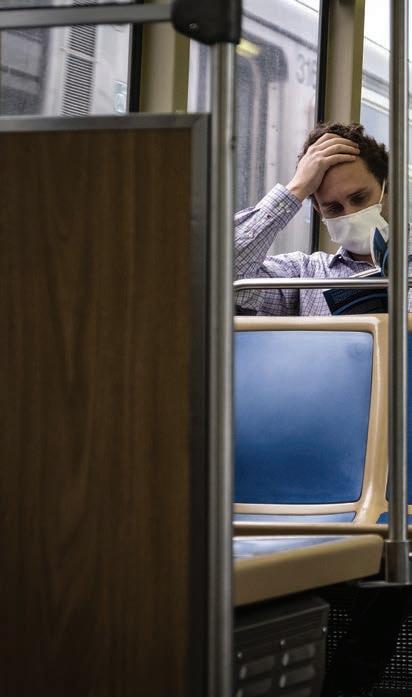
e Regional Transportation Authority has identi ed numerous funding sources, including increased sales tax and the expansion of the sales tax to services. Sales taxes are not the most equitable form of revenue, but sales taxes on services are potentially less regressive than those on goods. Plus, Illinois exing more highway dollars at the state level could indirectly free up some capital dollars for transit systems' operating costs. A more equitable approach would be a progressive income tax. This month's Illinois election results showed the majority of voters think the richest should pay more to relieve tax burdens. Once the public transit deficit

transit system that connects communities across northeastern Illinois. True reform would create a transit network that unites this region, allowing riders from any county to access affordable, dependable transportation without barriers.
A reimagined transit system would better serve the full spectrum of residents, whether commuting to work, accessing ser-
vices or connecting with family across county lines. is is our chance to bring meaningful change, creating a transit network that encourages growth, strengthens regional ties and becomes the preferred choice for everyone in the region. Let’s commit to transformative reform that meets the needs of today and propels our region into a future of connected, accessible transit for all.
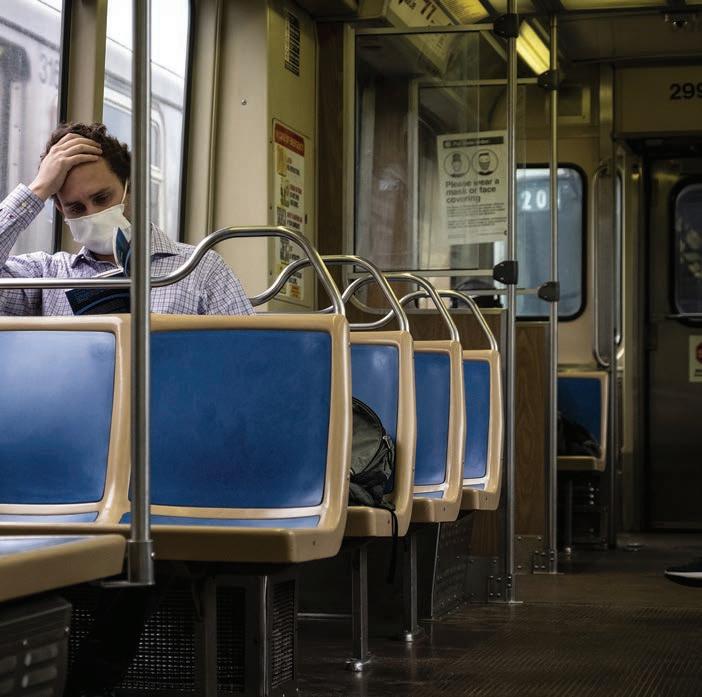
has a stop-gap measure, it’s time for a larger conversation on how critical public services, like education and public transit, do not just benefit users, but everyone. A progressive income tax could shift the cost of providing collective services to
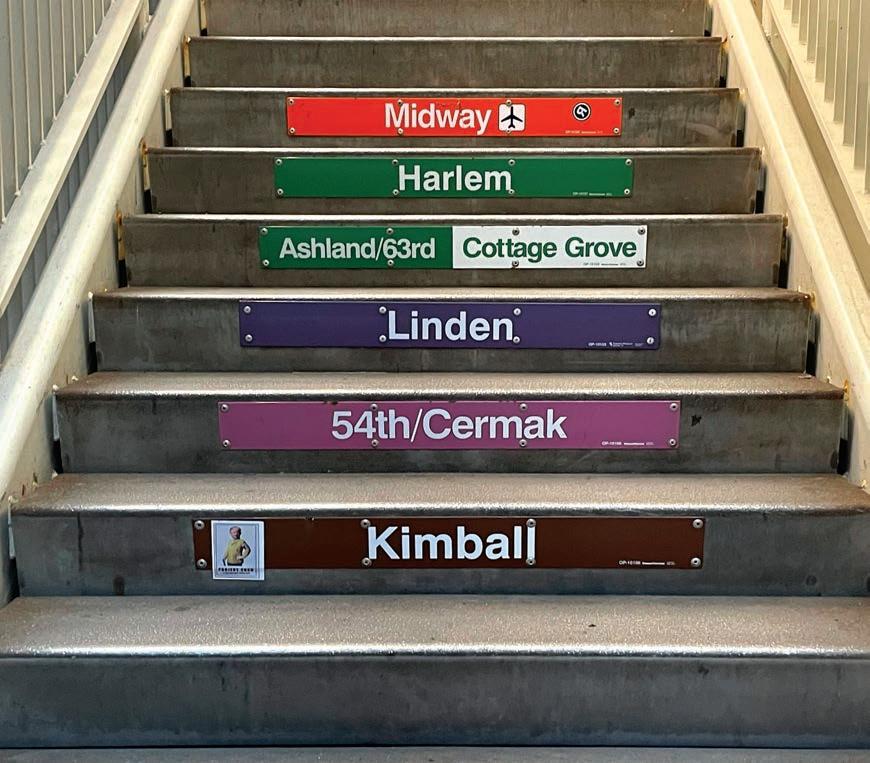
Most Chicagoans are aware of the struggles that COVID-19 brought to our transit systems, from inadequate service to the looming scal cli . e inconvenient truth is Illinois has chronically underfunded transit for decades, and many of the problems we face now were always there. e pandemic exacerbated them and made them impossible to ignore. And, in the face of a second Trump presidency, it’s more critical than ever that our state leaders take action to keep transit moving in Illinois.

operate and a model our region is overdue in adopting.
for Better Streets Chicago.
a more equitable model in which the richest pay their fair share. Federal dollars should also shift to support public transit operations, but national election results suggest that strategy, for now, is aspirational rather than actionable.
This spring, the Illinois General Assembly has the opportunity to confront the significant funding challenges that our transit systems face and reform the way they’re governed, operated and planned — addressing the long-standing failures of our disparate systems. Passing the Metropolitan Mobility Authority Act (MMAA) would mergethe Chicagoland’s transit agencies and the Regional Transportation Authority into a single entity. In practice, this means a rider should not notice a difference when moving between services, whether that’s the el, a bus or Metra. This is how many of Chicago’s global and national peer cities already
A uni ed agency will be better equipped to deliver a single regional fare system, close service gaps in the systems, coordinate schedules and operations across services, and capitalize on merged planning and capital development practices from a regional view — shedding the current governance model that silos the region’s transit agencies, headed by leaders who aren’t incentivized to collaborate. is would allow us to move beyond thinking about Metra as a service just for suburban riders when a third of the system’s stations are in the city of Chicago (with huge potential for growth), or to move beyond a system where a busy route like the CTA’s 20 Madison bus arbitrarily ends midway down a major commercial corridor just because it reaches the city’s edge.
Critically, the MMAA would infuse an additional $1.5 billion annually in state support for transit and eliminate Illinois’ outmoded fare recovery requirements. This represents a significant investment in transit, allowing our region to truly capitalize on the benefits of regional operations and planning provided through a
unified agency.
e current system is failing working-class Chicagoans and hampers regional economic growth, environmental sustainability and quality of life. Many residents’ only option is to drive as their primary mode of transportation, despite our region’s extensive transit system and strong public support for increasing investment in transit and expanding services. One of the best things we can do for Chicago’s working-class residents (who are the vast majority of us) is to invest in a transit system that liberates people from the scally, socially and environmentally unsustainable mandate to own a car.
Illinois has delivered a series of signi cant progressive wins that are reshaping the Prairie State as a model alternative to the reactionary, divisive and exploitative policies of Donald Trump and MAGA Republicans. We are proving it is possible to invest in the working class without scapegoating minorities, to protect reproductive rights and bodily autonomy, raise the minimum wage, and decarbonize our economy without compromising the socioeconomic diversity that is our state’s strength. Investing in transit and reforming the way it’s governed is a critical next step to deliver for working-class Chicagoans and demonstrate that Illinois is prepared to lead us into the future.
What makes a city like Chicago a special place? A core element that draws people — and makes them want to stay and build and invest — is the ability to get around easily and predictably. e only thing that makes that possible at scale is mass transit, which can move lots of people to lots of places conveniently.

Audrey Wennink is a senior director for the Metropolitan Planning Council.
A century ago, visionary leaders saw the growing population and overcrowded streets and built the system we have today, expecting it to be maintained, improved and expanded. Unfortunately, the civic momentum of past decades has not only stalled, but now has reversed. We are at a critical turning point. We have the power now to make choices that can harness the “make no small plans” approach and restore Chicago's transit system to one where people can once again easily, affordably and predictably get around the region.
Transit service has been declining for the past decade, which has contributed to ridership losses. e “spiral” that transit is facing
Agood compromise is when all parties are equally unhappy. at’s not true for the delivery of a critical public service. No one is happy with public transit in our region. It is time for that to change.
now is a threat to our region’s economic competitiveness and quality of life. Since the COVID pandemic, buses and trains are not showing up when scheduled, and riders are frustrated. People cannot plan their lives, they are missing connections, and they are wasting time. Riders also cite safety, both perception and reality, as a reason not to ride. Residents have been guring out other options to get around and are driving more. As a result, we now have more tra c than before the pandemic.
So what would a mass transit system be tting Chicago, the "Great American City," look like? How do we create a system that people want to ride? Chicagoans marvel at their transit experiences in global peer cities like London, Paris, Vancouver, Hong Kong and Tokyo. At its core, transit must be reliable, frequent and safe. Let’s face it, everything else in our lives is meticulously designed for the optimum user experience. To compete, we must expect more than merely restoring our transit system to the sta-
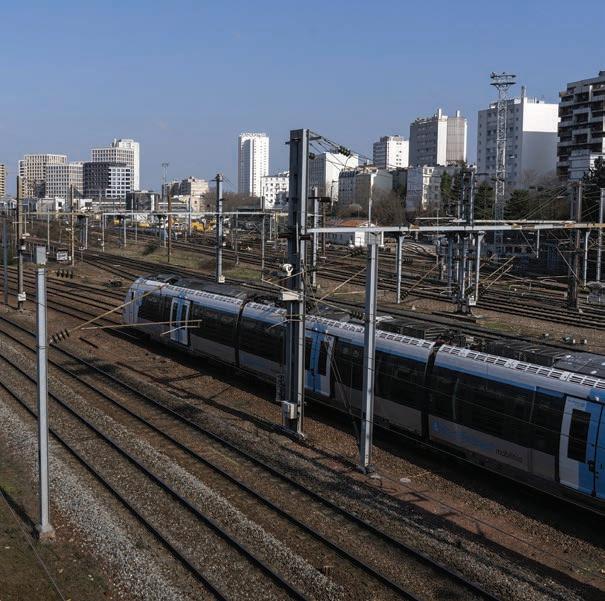
e
be on time, but
to
and
not
also
. and have Wi-Fi! So how can the Chicago region get there? First, we need improved transit governance. Right now,
there are four transit bodies — the Regional Transportation Authority, the Chicago Transit Authority, Metra and Pace — that set fares, plan routes and oversee budgets. is structure was set up decades ago as a rickety compromise and
never really worked to deliver what riders want: convenient and seamless transit trips around the region. We need to now do what should have been done a long time ago: consolidate the agencies into one agency that does coordinated regional planning and delivers integrated service. is is entirely achievable.
Second, we need to invest more in the operation of the system — the funds that pay for the buses and trains to run frequently and predictably. e return on this investment will generate an exponential increase in regional economic growth and quality of life for residents. It will position Chicago as a leader for private-sector investment and job creation. It will reduce air pollution and improve climate resiliency. And it will connect people to jobs, restaurants, schools, medical facilities, parks and cultural sites that make Chicago special.
Reinvigorating our transit system is no small task, but it is not harder than reversing the Chicago River, building the tallest skyscraper in the country or making Chicago a global center for the quantum computing industry. Now is the time. ere is a way forward. We can do this.
reform, more money won’t x region’s awed system

A FY 2026 scal cli of $730 million looms over our regional transit system. It is a challenge that o ers the last, best generational leverage opportunity to effect governance reform for a system that is not working well for anyone. e main source of corrective funding is the state of Illinois. at means us. But without a governance x, this critical infrastructure pillar will hamper e orts to build an equitable, next-wave regional economy.
e current decades-old system is comprised of four agencies lacking structural and operational coherence. e Regional Transportation Authority spans the sixcounty region, with two nominal “operating divisions” — Metra, the commuter rail service, and Pace, for suburban bus and regional paratransit. Both have separate governance boards, and the RTA lacks direct control over their operations. Most Metra trips start or nish in Chicago, but Chicago lacks meaningful board representation. e fourth agency, the Chicago Transit Authority, provides bus and rail service to Chicago and adjacent Cook County sub-
urbs, and delivers over 80% of the region’s transit trips. However, the CTA is not an “operating division” of the RTA and has its own governance board (with no county representation). e system is a national outlier — neither integrated nor clearly geographically delineated.
Aligning economic activity and opportunity means transcending geography. Governing to geography reinforces adverse e ects of politics on public administration. e existing lack of structural clarity and oversight results in self-perpetuating, hyperpolitical silos that fail to deliver what our 21st-century regional economy will need to thrive.
e proposed Metropolitan Mobility Authority Act (SB 3937) — the subject of ongoing community and legislative hearings — would vertically and horizontally integrate governance consonant with regional operational objectives and economic imperatives and add missing independent transparency and accountability mechanisms. e legislation would better situate us to harmonize competing, con icting and politicized objectives, and provide unied vision, direction and oversight that would justify the greater federal and state funding needed. e existing system delivers important infrastructure to our region’s vitality, but governance is perpetuat-
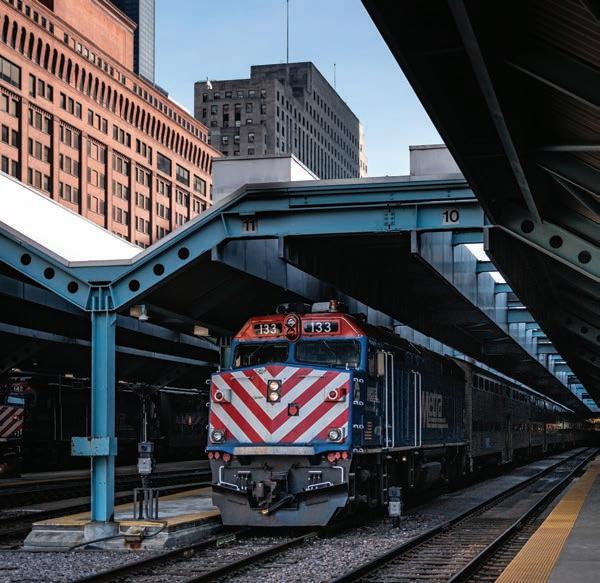
ing a mediocre status quo. at the current agencies object to consolidation is no surprise. e CTA re exively dismisses reform. Its president recently stated, “It’s much easier to say that bureaucracy is the problem . . . than to make tough decisions and take tough votes about raising revenue.” His solution for what ails a CTA perceived as underperforming in many respects? More taxpayer money and no reform. More money is needed. e current funding model is tied to unre-
alistic fare-box revenue requirements out of alignment with peer systems. Proponents of reform, in fact, are exploring sustainable future streams to address not only the projected de cit, but also the greater $1.5 billion the Chicago Metropolitan Agency for Planning (CMAP) — working with policy, civic and business partners — identi ed in December 2023 as needed annually, assuming reform. And theirs was not the rst call for governance reform. Prior expert calls for reform date to a
2007 Illinois auditor general report and 2014 studies from a government commission and a nonpartisan policy institute. e Civic Federation has long seen it as a both/and — reform as a precondition to funding.
e RTA pitches a middle path. Not surprisingly, it would bring more power and money to the RTA. A public transportation expert familiar with the RTA’s history and inner workings recently professed to being unimpressed, saying consolidation of the agencies is needed now. High on his list of reasons is that the CTA has long failed to collaborate without the RTA holding it to account. e state is conspicuously missing. It ponies up our money with no real oversight of how it is spent. It is shortsighted to have no meaningful state involvement in governance and oversight when regional public transit has so large an impact on the economic success of the state.
More money helps. But without reform, it only papers over structural and operational shortcomings of a system regarded by experts as deeply awed. e present call for more money without meaningful reform is a familiar local variation on the maxim about insanity — doing the same thing over again and expecting a di erent result, but with more taxpayer money. We can do better. We control our economic destiny if we put in the work. at must include regional transit governance reform.
By Jack Grieve
Veteran employees who have worked at the South Shore Line for decades say they have never seen a service issue as severe as the one that delayed commuters this month. About 40% of the rail line's cars were negatively impacted by at spots that for weeks remained inexplicable.
Now, rail operators are beginning to o er answers. e damages were not the product of inexperienced engineers, as some passengers have pondered, but rather leaves on the tracks causing train wheels to slide, the company said.
" e last two weeks of operations on the South Shore Line have been a struggle, and that we know is an understatement," South Shore Line President Michael Noland wrote in a message to passengers on Nov. 7. " e number of trains with car wheels out of tolerance was like nothing anyone on this railroad had seen or experienced in their entire careers. Due to this situation, our trains were late with extensive delays of 30 – 60 minutes or more
at times, as we changed out cars with out-of-compliance wheels." ousands of commuters who rely on the train to travel between Chicago and northwest Indiana were a ected by the delays. e culprit: a particularly bad "wheel slip season."
Leaf debris is a common foe for train wheels. It causes tracks to become slippery and reduces friction, which in turn leads to sliding wheels. When wheels slide, at spots are formed. e South Shore Line, which runs through the Indiana Dunes National Park, is keenly aware of this dynamic and has dealt with damaged wheels during the fall months for as long as it has existed.
Beginning in late October, however, engineers and mechanics began identifying at spots at alarming rates. "Every railroad that's got leaves around it faces this kind of issue," Noland told Crain's. "Just not to the degree that we faced this year."
Flat spots may not exceed 2.5 inches, per Federal Railroad Administration rules. e South Shore Line has a wheel truing machine that it uses to shave o wheel imperfections and return damaged equipment to service. e machine has been working nonstop these past few weeks, but it has not been enough to keep up regular service as so

many train cars were damaged. Noland is not sure why this year is worse than others. He is con dent the leaves are to blame, just not why the e ects of this year's fall season are worse than others. Nearby rail lines have not been a ected in the same way. e South Shore Line spent weeks trying to diagnose the issue. "We analyzed everything we possibly could," Noland said. ey checked to see if a change in the braking system could be
causing a problem. Maybe they had treated the lines with a chemical that was having unforeseen side e ects? Or, as some have suggested to Noland, perhaps new engineers lacked training and were to blame? None of those explanations panned out.
And while there remains some mystery, the rail line appears to have found a solution — though it can't say de nitively what solved the problem. "I think we've probably done four or ve di erent
things," Noland said, referencing the changes made to address the issue. To name a few, the company is prioritizing double-decker cars, using a brush to clean the rail lines and relying on air braking over dynamic braking. All of those could reduce sliding. "Can I tell you which one of those has worked? Nope," Noland said. "What I can tell you is, cumulatively, we haven't had these issues since we implemented the changes (on Nov. 4)."
By Laurence Iliff, Automotive News
Rivian Automotive and Volkswagen Group formally launched their joint venture with a potential $5.8 billion deal to bring next-generation electrical architecture and software for both automakers’ electric vehicles based on Rivian’s current technology, the companies said Nov. 12.
e automakers announced the deal in June. Since then, the size of VW Group’s investment in Rivian and the joint venture has risen from the initial estimate of $5 billion. Rivian is bringing its technology to the table and Volkswagen Group is bringing its global scale, executives said.
“The partnership with Rivian is the next logical step in our software strategy,” said Oliver Blume, CEO of Volkswagen Group. “With its implementation, we will strengthen our global competitive and technological position.”
In a joint statement, the automakers said the tie-up will aim to use the existing Rivian electrical architecture and software,
enabling the launch of Rivian’s next vehicle, the R2 crossover, in 2026 and the rst models from VW Group as early as 2027.
“Today’s nalization of our joint venture with Volkswagen Group marks an important step forward in helping transition the world to electric vehicles,” Rivian CEO RJ Scaringe said. “We’re thrilled to see our technology being integrated in vehicles outside of Rivian, and we’re excited for the future.”
After the initial phase of applying Rivian’s electrical system and related software to VW Group vehicles, the automakers will develop an architecture for software-de ned vehicles that will nd its way into a variety of brands, including Audi and Porsche, Blume said on a conference call with reporters.
e next-generation software platform will allow for advanced automated driving features and over-the-air updates that can add value to VW Group vehicles over time, Blume said.
e joint venture does not include other aspects of vehicle development, such as the use of Rivian’s in-house electric mo-

tors, Scaringe said on the call.
“ e scope of the joint venture is electronics, the network architecture, the software stack,” Scaringe said. “Any type of partnership, whether it be looking at sharing production capacity, sharing vehicle platforms, sharing propulsion hardware, that would be independent and separate from what we’ve announced today.”
Scaringe told analysts in early November that VW Group will independently design its vehicles and choose its infotainment systems. VW Group plans to launch EVs under its new Scout brand in 2027, including a pickup and crossover that are similar to the Rivian
R1T and R1S now on sale.
Scout Motors CEO Scott Keogh on Nov. 12 via LinkedIn said the startup’s vehicles will be among the rst to use the new zonal architecture built by the joint venture.
“It makes total sense to combine American manufacturing and technology to deliver Scout vehicles that customers want to own and love,” Keogh wrote on LinkedIn.
e automakers also announced the co-CEOs of the joint venture: Rivian’s software chief, Wassym Bensaid, and VW Group’s chief technology o cer, Carsten Helbing.
“Teams will be based in Palo Alto, California initially, and
three other sites are in development in North America and Europe,” the companies said in a statement. “By combining their complementary expertise, the two companies plan to reduce development costs and scale new technologies more quickly.” e deal with VW Group is critical to Rivian’s future as it burns through cash on the road to pro tability.
In the third quarter, the EV maker reported a net loss of $1.1 billion and a sharp fall in revenue on lower production and deliveries. In the year-earlier quarter, Rivian’s net loss was $1.4 billion.
Rivian loses money on every vehicle it sells, and it fared worse in the third quarter. e automaker’s gross loss per vehicle delivered was $39,130 compared with $30,648 in the year-earlier period, it said.
ird-quarter revenue fell to $874 million from $1.3 billion in the same period last year. e 35 percent decline was Rivian’s rst quarterly decrease since listing on the stock market three years ago.
Rivian said it had cash and cash equivalents of $5.4 billion at the end of the quarter.
Jack Walsworth contributed to this report.
Laurence Ili writes for Crain's sister brand Automotive News.
geniant, Chicago

The Opus Group, Chicago
Loyola University, Chicago
Hahn Loeser & Parks, Chicago
Teach for America Greater Chicago-Northwest Indiana, Chicago

Randolph
Mel Chotiner, NCIDQ and Peter Randolph, AIA have been promoted to Design Principal at geniant, a design rm focused on shaping impactful experiences. In this new role they will oversee a team of designers and architects, fostering growth and setting standards for excellence. Peter and Mel will work closely with rm leadership to drive business development, ensure quality standards, and promote geniant’s values of inclusivity and innovation. Mel’s commitment to industry-wide Diversity Equity & Inclusion re ects her passion for creating impactful, forward-thinking spaces that resonate with clients and community. Peter’s reputation for delivering award winning design will continue to propel growth and excellence of the geniant team.

Lamar Johnson Collaborative, Chicago
Lamar Johnson Collaborative (LJC) welcomes Stanley Schultz as Associate Principal to its Chicago of ce. His experience in architecture, fabrication, and industrial design spans various sectors, including mission critical, civic, and cultural projects, with a focus on DfMA (Design for Manufacturing and Assembly) and productization. Stanley is a leader in delivering solutions for large-scale, missioncritical facilities, specializing in the design and management of hyperscale data centers.

GNS North America, Grand Rapids / Canton
Mike Alcala has transitioned from CEO to the role of Vice Chairman/Board of Directors and Chief Executive Of cer Emeritus at GNS North America. In his new role at the Tier 1 supplier, Alcala will oversee the C-suite leadership team; business planning processes; market and customer strategy; and leadership development.


GNS NA also announced that Chris Eisenhart has been promoted from Chief Operating Of cer to Chief Executive Of cer. Eisenhart, who joined the company in 2021, will continue to report to Alcala. He has played an instrumental leadership role in operations and in the development and enhancement of business processes. The moves complete a planned leadership transition.

The Opus Group® has promoted Paul Robertson and Mike Robinson to vice president of real estate development in our Chicago of ce. Paul is responsible for sourcing and managing multifamily communities in the greater Chicago area, including the award-winning Dash Downers Grove. As vice president, Paul is leveraging his depth of knowledge and experience as Opus extends its multifamily presence into Charlotte, North Carolina.


Robinson
Mike has managed the development of three million square feet of industrial property throughout Chicago, Detroit and Northwest Indiana. A talented industry veteran, in his new role, Mike is continuing to lead Opus’ industrial developments in those markets, from sourcing and pursuit through construction, leasing and sale.
FTI Consulting, Chicago
FTI Consulting adds industry veterans David Duschene and Timothy Peters to its Strategic Communications segment as Senior Managing Directors. With deep expertise across multiple sectors, Dave and Tim will further strengthen the rm’s capabilities at the intersection of reputation management, public affairs and issues management. Working with an already strong and growing communications team in Chicago, they will help clients navigate an increasingly volatile social, commercial, regulatory and political environment in the Midwest, as well as in key markets around the globe, leveraging FTI Consulting’s global platform.


Jim Parenti has been named Dean of the School of Continuing and Professional Studies at Loyola University Chicago. Previous to Loyola, Dr. Parenti was Senior Advisor to the President at Georgetown University, where he also served in a number of leadership roles. A graduate of Baldwin-Wallace University, Dr. Parenti holds a master’s degree from Northwestern University’s Medill School of Journalism, and completed his doctoral studies at The Peabody School at Vanderbilt University.

Hahn Loeser welcomed Associate Carling D. Miller to its Intellectual Property team. Miller brings a background in laboratory work specializing in research on Neuro bromatosis type 1. She will focus on IP legal issues, including trademarks, copyrights and patents. As a law clerk, she performed trademark searches and contributed to search opinions. Miller earned a J.D. from Illinois Chicago School of Law and a B.S. in Genetics and Genomics from Wisconsin.



Wintrust Financial Corporation, Rosemont
Wintrust Financial Corp., a nancial services holding company based in Rosemont, Illinois, with more than 200 locations in the greater Chicago, southern Wisconsin, west Michigan, northwest Indiana, and southwest Florida market areas, is pleased to announce two promotions. Felipa Aguirre was promoted to VP, Chief Administrative Of cer, Mortgage. Felipa joined Wintrust in 2019. Christopher Conversa promoted to SVP, Division Manager, Commercial Banking. Christopher joined Wintrust in 2020.

Parts Town Unlimited, Addison
Chris Dacey has been deeply involved in Parts Town Unlimited’s business as Operating Partner at the company’s lead private equity sponsor, Berkshire Partners. He joins Parts Town Unlimited as the company’s new Chief Strategy and Operations Of cer, leading strategic planning, operations, IT and project management to drive innovation and growth.





West Monroe, Chicago
Kamau Coar joins West Monroe as General Counsel. In his new role, Coar will oversee legal and compliance, managing corporate governance, regulatory, trademarks, and IP. Coar will also serve as board secretary, playing a crucial role in supporting West Monroe’s board. With extensive experience in employment law, M&A transactions, international business, and corporate governance, Coar is well-positioned to support the rm’s expansion. He previously served as Counsel at Nixon Peabody LLP.

Shirley Ryan AbilityLab,
Shirley Ryan AbilityLabthe no-1 ranked research rehabilitation hospital serving adults and children with the most severe, complex conditions — has appointed Marcos DeLeon as chief people of cer and Karen Paciero as chief advancement of cer. DeLeon will oversee human resources for 2,800 clinical, research, support services and administrative team members based at the organization’s agship hospital and sites of care throughout the Midwest. Among other areas of focus, Paciero will lead the organization’s completion of its $100 million Accelerate Ability campaign. She also will serve as President of its Keystone Board.

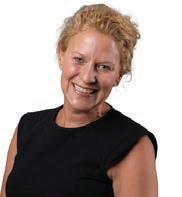

TFA GC-NWI is proud to announce the addition of Melody Spann Cooper to its regional advisory board. Melody is an innovative entrepreneur and communications leader with over 30 years of experience in media management, marketing and community engagement. She is Chair and CEO of Midway Broadcasting Corporation and is experienced in government, civic and non-pro t organizations. Melody brings diverse expertise and a deep commitment to advancing educational equity in the Greater Chicago region.
Teach for America Greater Chicago-Northwest Indiana,

TFA GC-NWI is proud to announce the addition of Rodney Jordan to its regional advisory board. Rodney Jordan is the Global Chief Operating Of cer for Ronald McDonald House Charities, Inc. (RMHC), a non-pro t, 501(c)(3) corporation. Rodney brings diverse expertise and a deep commitment to advancing educational equity in the Greater Chicago region. Prior to RMHC, Rodney held several leadership positions at McDonald’s Corporation, including Chief of Staff for McDonald’s Global Impact team.
Teach for America Greater Chicago-Northwest Indiana, Chicago
TFA GC-NWI is proud to announce the addition of Matt McKee to its regional advisory board. Matt is a Managing Director and Investment Specialist at J.P. Morgan Private Bank in Chicago. He guides business owners, family of ces, and multi-generational families in managing investment challenges, delivering tailored and differentiated strategies that align with their speci c needs. Matt brings diverse expertise and a deep commitment to advancing educational equity in the Greater Chicago region.

Cold Bore Capital, Chicago


Frank Baumann has been promoted to Managing Director of Portfolio Management at Chicago-based Cold Bore Capital Management, where his responsibilities include ensuring that portfolio company goals are strategically aligned to maximize value and optimize returns. Prior to joining CBC in 2019 as an operating partner, Baumann held positions at Optio Rx (a CBC platform company) and Medtronic, and served as an intelligence of cer in the U.S. Navy for eight years. Baumann resides in Atlanta.

A partnership between a builder and an architect is now delivering its latest dozen units sold as shells to be tailored by buyers
By Dennis Rodkin
Earlier this month, a dozen buyers of condos in a new Lake Forest building closed their purchases at $1.2 million and up, but they can’t move in yet.
at will be next year, after the condos’ white-box interiors are custom-built to each buyer’s taste and speci cations, at an additional cost.
e 12-unit building on Kelmscott Way is the fourth in downtown Lake Forest that builder Todd Altounian and architect Peter Witmer have developed with a “have it your way” strategy. e rst three buildings, completed since 2018, contained a combined 26 condos, all delivered in the same untailored state. Kelmscott will add 12 to that tally, and Altounian says he expects to start construction in the spring on an eight-unit building done the same way on Scranton Avenue in Lake Blu .
e strategy, which is rare but not unique, clearly has found its market among a uent North Shore buyers.
Altounian said the appeal has grown in the past few years, because empty-nesters who in the past might have bought a new condo in downtown Chicago “don’t want to deal with the city anymore. ey want to be in the burbs” as the generational move downtown has lost its luster in the 2020s.
Like a bespoke suit, a bespoke
condo appeals to a discriminating buyer.
“ ese are buyers who are experienced with homes and have the time to wait to get what they want,” says Susan Amory Weninger, the @properties Christie’s International Real Estate agent who led sales in the Kelmscott Way building.
e buyers, largely emptynesters and retirees, “have had the big house on Lake Road or May ower Road,” Altounian says, and when downsizing they often want something comparable in style.
One may want a traditional formal dining room “like they had in the big house,” Altounian says, or an expansive kitchen that a typical condo oor plan wouldn’t have. Others might want a more contemporary open plan or a bedroom con gured to suit a hospital-style lifting bed for a senior.
Tailoring the space extends well beyond installing bookcases in the living room to laying out the rooms as the buyer wants them. e structure is pre-cast concrete, “so we don’t have load-bearing walls” on the interiors, Altounian says. “You can place the walls anywhere you want.”
Altounian delivers units that have plumbing and utilities, but no nishes, then the buyers work with Whitmer to design the interior of their unit. e buyers have two separate purchase contracts, one for the shell and

another for the nishes that make it living space.
Nine units closed in the new Kelmscott Way building on Nov. 6 and Nov. 8 at prices between $1.2 million and $1.9 million. Ranging in size from 3,000 square feet to 4,200 square feet, they’re selling for an average of about $500 a square foot.
e nishes may take that up to the $775-a-foot range, although it all depends on the selections the buyers make, said Amory Weninger. at is, the $1.2 million white
box will likely have a total cost in the range of $1.68 million, and the $1.9 million unit will nish out at a total investment of around $2.66 million. e buyers pay in cash, with no mortgage, Altounian and Amory Weninger both said. For the most part, they’re not moveup buyers who need to sell the old address to fund purchase of the new one, another factor that makes paying for nishes separately feasible.
The Kelmscott Way condo building is the last piece of a
10.7-acre redevelopment area on the north edge of Lake Forest’s downtown area. Formerly the site of the city’s public works department and other administrative offices, it was targeted for redevelopment in 2007 and approved for about 150 housing units in 2016.
e city of Lake Forest sold the land to Focus Development Group, which built apartment and single-family components of the Kelmscott Park neighborhood before selling the condo site to Altounian’s group.
The grocery chain is in an all-out expansion blitz but still closing some stores in the city Aldi closed another Chicago store, this time on the South Side
By Jack Grieve
Aldi is in an all-out expansion blitz, but for some Chicago residents it feels like a di erent story. e discount grocery chain abruptly closed its store in West Pullman on Nov. 10, just six weeks after shutting down another location in Lincoln Park.
The latest closure stings particularly hard for folks in the Far South Side neighborhood. Unlike in Lincoln Park, where a half-dozen, big-name national grocers still operate, West Pullman residents now have very few grocery options within walking distance.
As Ald. Ronnie Mosley, 21st, wrote in a statement, "this closure will leave West Pullman, already a food desert, without a single grocery store offering affordable, high-quality fresh food." There are still a few
smaller shops nearby, plus a recently reopened Save A Lot about one mile north of the shuttered Aldi. Mosley cast the closure as the chain turning its back on West Pullman.
His statement echoed some of the sentiments expressed following other recent Aldi closures in West Garfield Park and Auburn Gresham.
Aldi, which now has 32 Chicago locations, has long been seen as a model for South Side grocery operators. The chain found a blueprint for keeping costs low and winning over customer loyalty. As other national brands left, Aldi stayed.
The West Pullman closure comes as Aldi plans to spend $9 billion and hire thousands of new workers to open 800 stores nationwide by the end of 2028, including 330 stores in the Midwest and Northeast. One of

those stores is slated to open in the West Loop in 2026.
"The recent closures are
unique situations and not indicative of any larger trends," an Aldi spokesperson said in a
New construction has been selling well at the upper end in recent years, not only because buyers want a custom-tailored place but because the upper-end market has been booming overall. Year to date as of Nov. 12, there were 75 homes sold at $4 million or more in the Chicago area, compared to 73 for all of 2023.
e year is unlikely to close with more sales than 2022 and 2021, which both crossed the 100-sales mark, but it is stacking up to be the third-strongest sales year on record for the upper extreme of the housing market. at’s at a time when sales at all prices appear to be headed for their weakest in at least a dozen years.
Of last year’s $4 million-plus sales, six were new-construction houses, the highest priced a seven-bedroom house on Cleveland Avenue that sold for about $6.18 million. So far this year, there have been ve sales, topping out at $7.2 million for a new house on Howe Street about which few details were published on real estate sites. ree more are under contract to buyers. If they nish and deliver in the next six weeks, the year-end total will be eight, up from six last year.
Here's a look at the ve newconstruction homes that have sold for the highest prices so far in 2024.
1. Howe Street, Lincoln Park
Sold for $7.2 million in September
◗ In 2022, the proli c Lincoln Park developer Environs bought all four condos in the building that was on this site, for a combined total of about $2.6 million, according to the Cook County clerk.
e rm replaced that early1980s building on a 33-foot lot with this seven-bedroom, 9,000square-foot single-family home with a classically styled limestone facade.
e buyers used a land trust
From Page 1
Several council members expressed concern for the vacancies during the hearing and probed Ige’s team about what could be done to ll them. Ald. Daniel La Spata, 1st, pointed out that mental health clinician jobs make up one of the largest categories of vacancies, a fact that could threaten the future success of the CDPH’s plan to continue reopening and operating public mental health clinics across the city.
“Persistent vacancy rates are really concerning,” La Spata said. “If the solution really is that we need to o er more competitive salaries, I think (the) council needs to hear that.”
Despite the challenges, Ige said the CDPH has successfully hired all the employees needed to operate a Roseland mental health clinic, which is slated to open in December, but noted it’s had to make compromises to do so. Instead of hiring a psychiatric doctor, the
that conceals their names in public records.
2. Howe Street, Lincoln Park
Sold for $6.8 million in April
◗ No photo is available of this house, also built by Environs and less than a block north of the rst property on this list.
e mansion replaced a fourunit condo building and the house next door, which Environs acquired in separate transactions totaling about $3.4 million in 2022, according to the Cook County clerk.
ese buyers also concealed their names in public records via a land trust.
3. Saucer Court, South Barrington
Sold for $5.3 million in October
◗ When it sold in early October, this six-bedroom, 15,000-squarefooter set a new record for South Barrington.
e buyers, who are not yet identi ed in public records, “are a multi-generational family who needed multiple primary bedroom suites, which this house provided,” says Sammy Lubeck, the Baird & Warner real estate agent who represented them. at was a result of the house’s slightly unusual history. While it was new construction, it had been built for other buyers. Listing agent Steve McEwen of @ properties Christie’s International realty explained to a Crain’s reporter at the time of the sale that a couple spent about four years building it for themselves, but before it was nished they moved to Florida. At completion, they put it up for sale.
eir priorities for how to apportion space happened to line up with the needs of Lubeck’s clients. e house also has two kitchens, an elevator and an eight-car garage, all amenities that would make multi-generational living easier.
4. Altgeld Street, Lincoln Park
Sold for nearly $4.6 million in October
◗ A six-bedroom house on a lot
CDPH has opted to hire psychiatric nurses, which would demand lower salaries, for example.
While raising wages could help o set some workforce challenges, the CDPH faces a severe funding cli that will likely make it harder to do so. e department’s budget has been slowly shrinking since the COVID-19 pandemic, when it received an infusion of grant dollars from the federal government to address the health crisis.
e CDPH’s budget is expected to shrink 16% next year to about $700 million, and by the end of 2026, the budget will lose an additional $250 million in one-time COVID grants, a department spokesperson said. Unlike some other city agencies, the CDPH’s budget relies heavily on grants.
Nearly 90% of the CDPH’s 2025 budget is made up of grant funding, 46% of which is one-time grants.
“Sustainability has been a top priority for CDPH,” Ige said.
Further complicating scal stability at the CDPH is the reelection of Donald Trump, whose intentions for federal health care
40 feet wide “is the kind of big home and massive yard that people want in the city,” says Konrad Dabrowski, the Fulton Grace Realty agent who represented the buyers of this home. It was built by Eric Flanagan’s rm, Merrion Development Group. e buyers, not yet identi ed in public records, were people who already lived within a few blocks of this property and “came in really early in the process, probably around drywall,” Dabrowski says, so “they were able to customize it to their liking. In this demographic, they will pay to get it the way they want it.”
5. Janssen Avenue, Southport Corridor
Sold for $4.37 million in August ◗ “ is house got a lot of interest from buyers because it had a lot going for it,” said Jason O’Beirne, the Jameson Sotheby’s International Realty agent who represented it for the builder, Lux Modern Development. ere’s the 37.5-foot lot, a three-car attached garage, and rooftop decks on two levels. Almost as important as those features, O’Beirne says, was the fact that the interior “was neutral in design, making it a starting point for (the buyers) to personalize it.”
Existing homes in the same price point, he says, sometimes have a little too much flavor, in part because the owners of multimillion-dollar homes aren’t hesitant to customize their space.
O’Beirne usually represents new construction at a less elevated price range, generally in the under-$2 million range. Builders at that level may be eyeing the healthy sales up at this level, but O’Beirne says few will make the leap.
“Most of my builders will say, ‘I can’t take that much risk on one address,’ ” O’Beirne says. ey’re more comfortable building in a price range they’re familiar with, he says.
spending are still unclear but could result in cuts to agencies like the Centers for Disease Control & Prevention, which issues many grants to the nation's public health departments.
During the hearing, Health Committee Chair Ald. Rossana Rodríguez-Sánchez, 33rd, asked about Ige’s expectations for collecting federal grant funding under the new administration, to which Ige said she was “optimistic” that the CDPH will at least continue to collect "recurring" grants, which make up about 41% of its 2025 budget. If grant funding — whether it be one-time or recurring — continues to dwindle, it will intensify the need for contributions from the city’s corporate fund. Ten percent of the CDPH’s budget next year is made up of corporate dollars, but that’s down slightly from the year before.
Ultimately, maintaining services at the CDPH may require that more tax dollars be funneled to the CDPH budget — a scenario public health advocates have been ghting for this fall.
10 tenants, including rewards app company Fetch, Burford Capital and NTT Data, according to a statement from Jones Lang LaSalle, which arranged the new mortgage on behalf of Vista.
e developer “was fortunate to have leased up 609 W. Randolph’s 15 oors of new construction to an impressive and diverse roster of high-quality full oor users,” Vista Principal Hymie Mishan said in the statement. “Our tenants enjoy close proximity to the expressway, suburban train lines, CTA transit, the West Loop and especially Fulton Market.”
Vista’s push to kick o 609 W. Randolph on speculation — or without any tenants lined up in advance — was gutsy amid the fog of a public health crisis in 2021, when many companies were embracing the remote work movement. Other, far larger o ce properties with lots of available space were under construction at the time, and the downtown o ce vacancy rate had jumped to about 18% from 13.8% at the beginning of 2020.
e developer’s thesis was validated by Bank OZK backing it with the construction loan. Now Vista has beaten the odds again by landing the JPMorgan Chase loan while the vacancy rate for downtown o ces sits at a record-high 25.8%.
A spokesman for JPMorgan Chase declined to comment on the re nancing.
From Page 3
misleading restaurants and consumers by publishing phone numbers that directed customers to the company, rather than restaurants, and that it improperly charged restaurants for phone calls that didn’t result in orders.
"We remain deeply disappointed by the city's decision to le this lawsuit,” Grubhub said in a statement. “Every allegation is wrong, and we will continue to defend our business."
e city declined to comment on the suit.
From Page 3
create a “good dynamic tension” that he believes will only bene t the business.
“Iron sharpens iron,” Costello said.
e move is a signi cant step for any family company, according to omas Handler, who advises wealthy families and their businesses and has served on several boards.
“ at willingness to look outside for assistance tends to preserve the family and the business and its a uence,” Handler said. “ ere's just all kinds of positives that can come from a move like this.”
e move can also signal that the company is ready to expand

Vista’s confidence that boutique West Loop office projects could defy pandemic-induced trends was so high in 2022 that it proposed another 15-story office building at 640 W. Randolph, just one block west of the 609 W. Randolph property. The City Council approved that plan last year, but Vista has not moved forward with it.
But the developer appears
Much has changed in the past three years. e battle for domination of restaurant delivery apps is over: With about 6% market share, according to Bloomberg Second Measure, Grubhub now is an alsoran behind DoorDash at 68% and Uber Eats at 26%.
Grubhub, which pioneered online restaurant ordering 20 years ago, has struggled since it was acquired by Amsterdam-based Just Eat Takeaway.com in 2021. Orders in the company’s North American business, a proxy for Grubhub, were down 9% through the rst nine months of 2024 from a year earlier. Now it’s being sold to New York-based private company Won-
and seek out new areas for growth.
e board will bring in industry leaders who are equipped to handle some of those questions and moves, explains Erik Gordon, a professor at the University of Michigan's Ross School of Business.
“You can now rely on experts with experience and skill sets in everything from mergers to going public or bringing in growth capital to help you expand,” Gordon said, adding that the board can also serve as an independent voice within family disputes.
In its job listing for board members, the company said applicants should have “experience with M&A and successfully scaling businesses.”
“Furthermore, future directors should have a profound understanding of corporate and mana-
poised to begin work on another ambitious project in the Fulton Market District. Vista last month released new renderings of a 32story, 494-unit apartment tower it has planned at 370 N. Morgan St., one block north of Google’s Chicago o ce. It’s unclear whether the developer has lined up nancing to begin work, but Vista recently obtained a permit to demolish the
der in what looks like a re sale that values the company at just $650 million — a deal that includes just $150 million in cash. Grubhub’s local headcount is down to roughly 750 from a peak of more than 1,200 in 2021.
Cities such as Chicago once were clamoring for permanent fee limits. But mostly those e orts have zzled. Restaurants now are more focused on rising costs of food, labor, rent and property taxes.
“ ings have evolved for both independent restaurants and thirdparty apps, who have come to a better understanding of each other,” says Sam Toia, president of the Illinois Restaurant Association.
gerial nance and experience with the nancial implications of organizational growth,” the listing reads. “Ideal candidates have experience working with complex multigenerational family businesses and an understanding of how to navigate family dynamics successfully.”
Costello said the company saw signi cant growth during the pandemic for its frozen pizza, which makes up more than 80% of the company’s revenue, as shoppers looked to stock up on easy options to cook at home. Revenue exceeded $100 million in 2022, up from about $80 million in 2019 before the pandemic, Costello previously told Crain’s. is year he said the company is eyeing around $150 million in revenue as its goal.
Costello said its frozen pizzas
existing industrial building on the site and said on its website it aims to break ground on the apartment project in the rst quarter of 2025.
e building would be the shortest of three towers Vista has proposed around the intersection of Morgan and Kinzie streets.
JLL’s Christopher Knight, Matt Maksymec and Katia Novi represented Vista in arranging the new mortgage for 609 W. Randolph.
“If you’re a restaurant owner or operator, you need to have thirdparty delivery as part of your plan," he said. "( e delivery apps) have come up with di erent packages. ere are cheaper alternatives now.”
at doesn’t mean the lawsuit will go away. Uber Eats reached a $10 million settlement with the city two years ago. DoorDash continues to ght its case with the city. Earlier this month, Illinois Attorney General Kwame Raoul announced DoorDash will pay $11.25 million to settle allegations that it had not properly shared customer tips with drivers — a practice that ended in 2019.
recently entered the California market, among others, as the company inked a deal for national distribution with grocery giant Albertsons, which owns Jewel-Osco and Safeway. He said it also recently landed a regional deal with Walmart for distribution in the Midwest and Southeast.
As far as what’s next, Costello said he wants to continue to expand into new markets. "Until we're nationally distributed by all the major retailers, we've got work to do," he said.
In addition to its frozen pizza business, Home Run Inn has nine restaurant locations in the Chicago area, plus one at Midway International Airport, which is licensed but not run by Home Run Inn, and four kiosks in O’Hare. It has around 500 employees and products in 40 states.
Pawan Naidu, Steven R. Strahler, Mark Weinraub Researcher Sophie H. Rodgers
ADVERTISING
Sales director Christine Rozmanich (312) 649-5446 or crozmanich@crain.com
Business development strategist Andy Rasero, andy.rasero@crain.com



